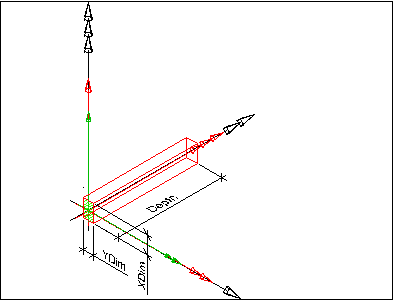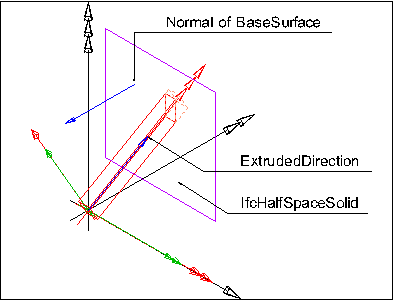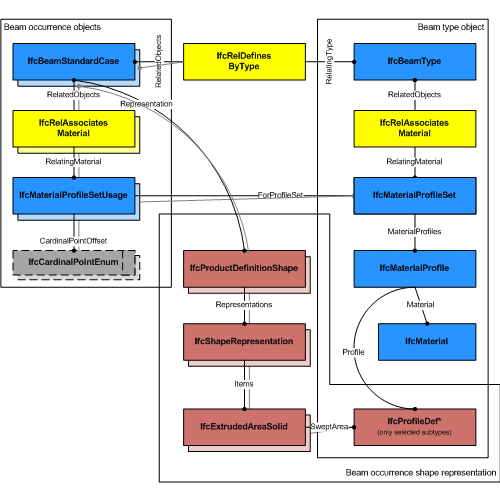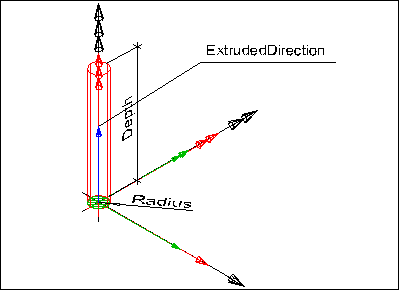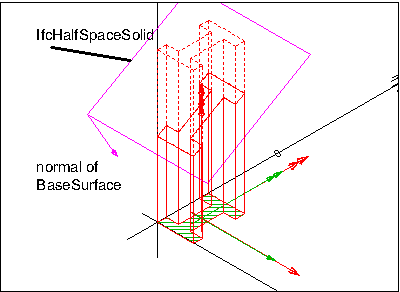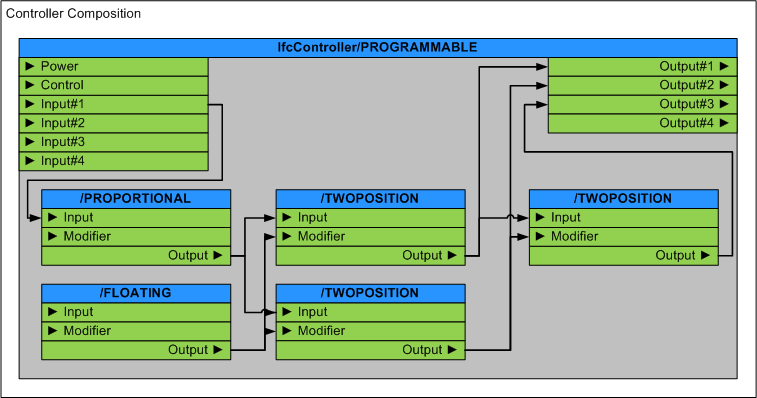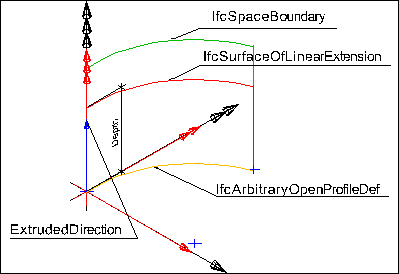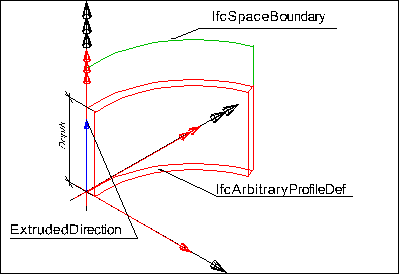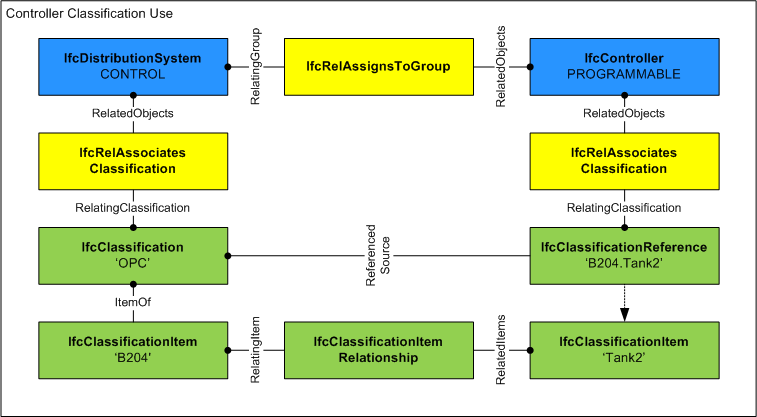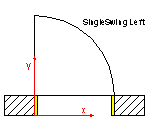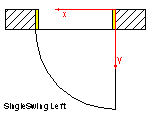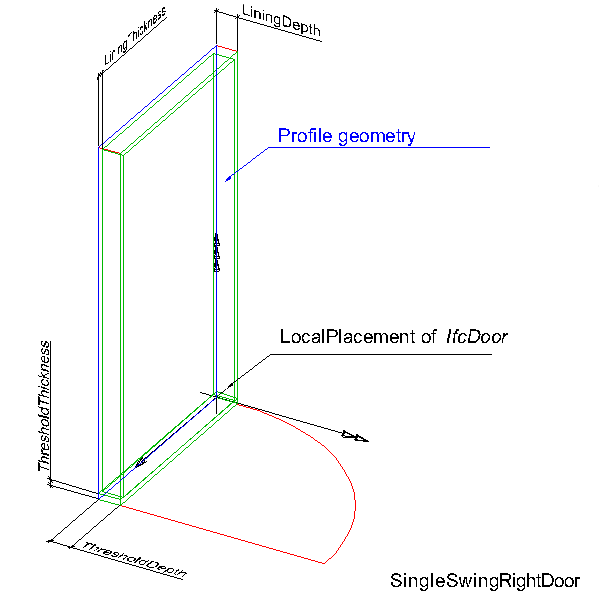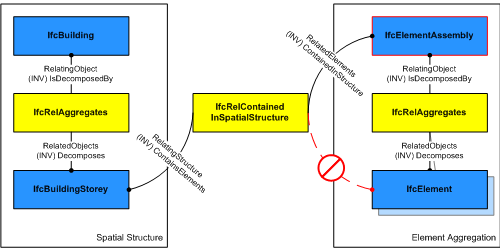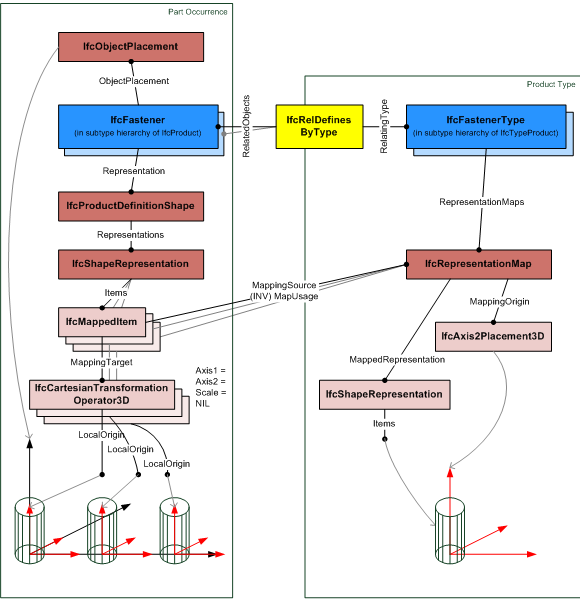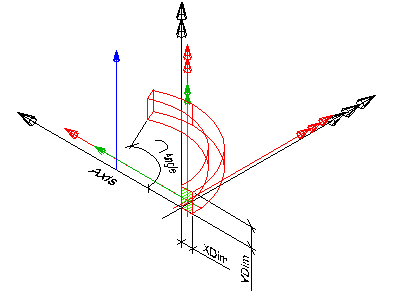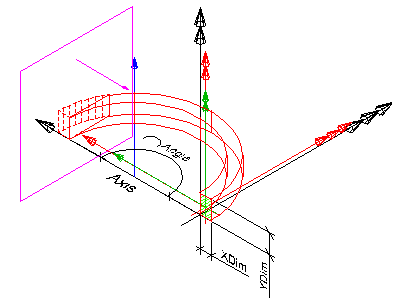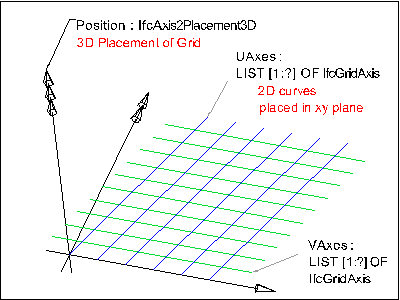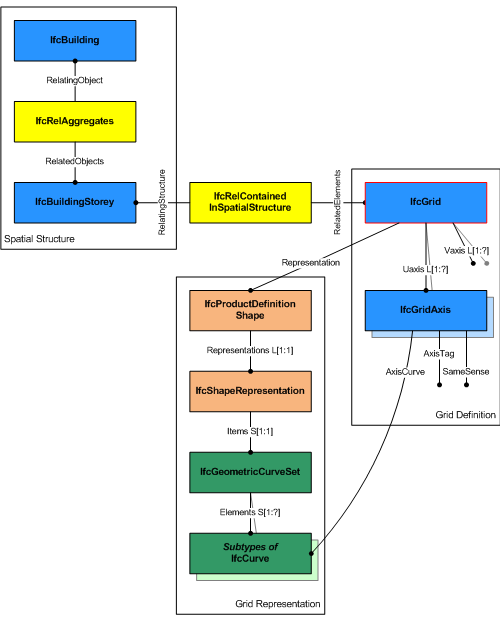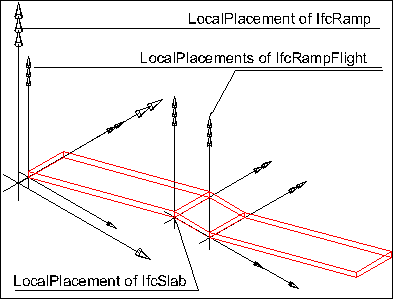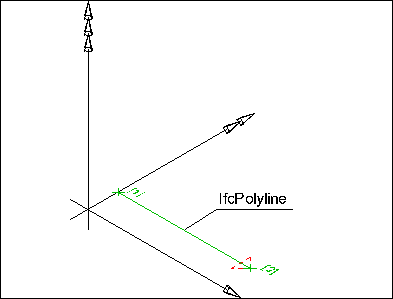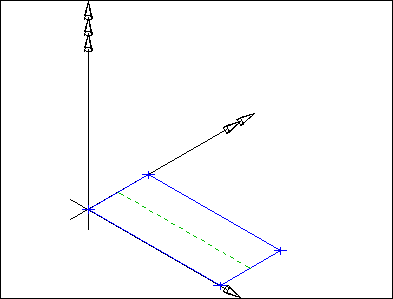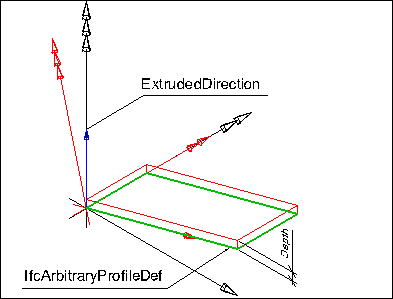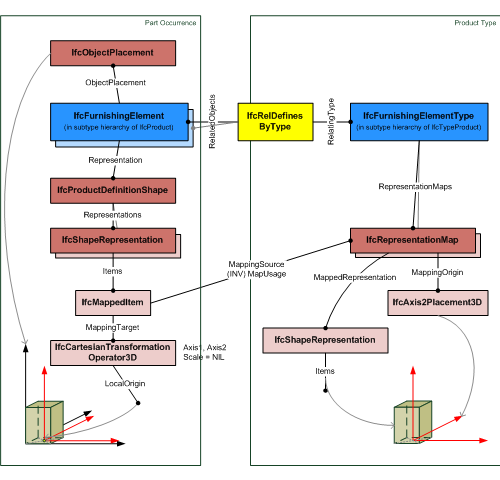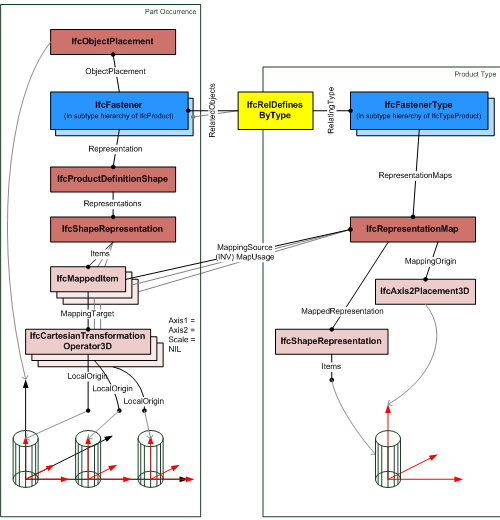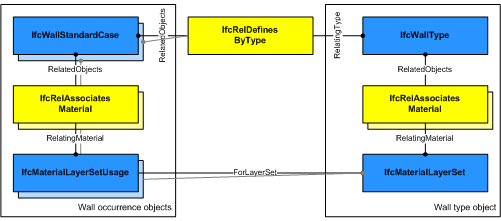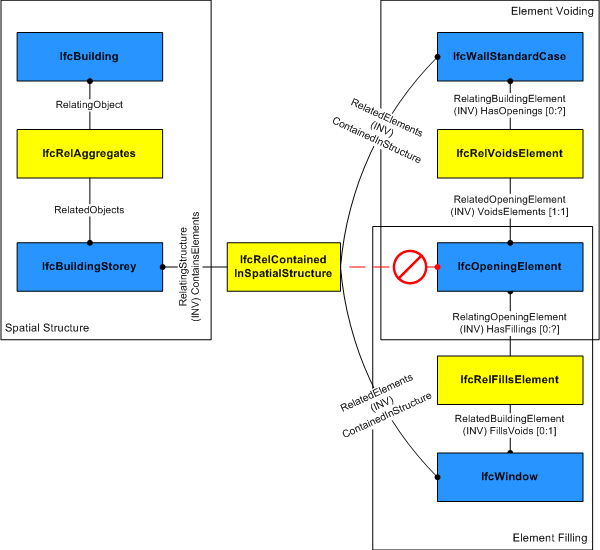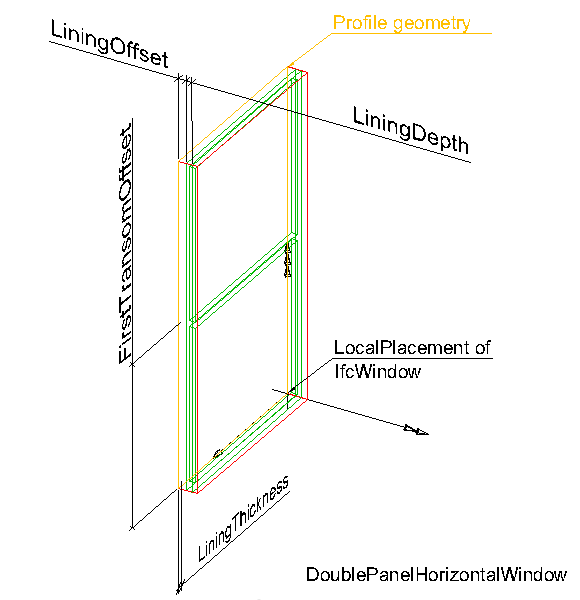* BIM exchange format definitions that are required during the life cycle phases of buildings:
* demonstrating the need;
* conception of need;
* outline feasibility;
* substantive feasibility study and outline financial authority;
* outline conceptual design;
* full conceptual design;
* coordinated design;
* procurement and full financial authority;
* production information;
* construction;
* operation and maintenance.
* BIM exchange format definitions that are required by the various disciplines involved within the life cycle phases:
* architecture;
* building service;
* structural engineering;
* procurement;
* construction planning;
* facility management;
* project management;
* client requirement management;
* building authority for permits and approval.
* BIM exchange format definitions including:
* project structure;
* physical components;
* spatial components;
* analysis items;
* processes;
* resources;
* controls;
* actors;
* context definition.
| Field | Mapping | Definition |
|---|
| (Query) | \IfcActionRequest
| |
|---|
| \IfcObject
| The IFC class identifier indicating the subtype of object. |
| Approval | \IfcObjectDefinition.HasAssociations[*]
\IfcRelAssociatesApproval.RelatingApproval
\IfcApproval.Name
\IfcLabel
| Approvals may be associated to indicate the status of acceptance or rejection using the IfcRelAssociatesApproval relationship where RelatingApproval refers to an IfcApproval and RelatedObjects contains the IfcActionRequest. Approvals may be split into sub-approvals using IfcApprovalRelationship to track approval status separately for each party where RelatingApproval refers to the higher-level approval and RelatedApprovals contains one or more lower-level approvals. The hierarchy of approvals implies sequencing such that a higher-level approval is not executed until all of its lower-level approvals have been accepted.
|
| Aggregation | | As shown in Figure 1, an IfcActionRequest may be aggregated into components.
 | Figure 1 — Action request composition |
|
| Nesting | \IfcObjectDefinition.IsNestedBy[*]
\IfcRelNests.RelatedObjects[*]
\IfcObject
| The object definitions, either non-product object occurrences or non-product object types, that are being nestes. They are defined as the parts in the ordered whole/part relationship - i.e. there is an implied order among the parts expressed by the position within the list of _RelatedObjects_.
{ .change-ifc2x4}
> IFC4 CHANGE The attribute has been demoted from the supertype _IfcRelDecomposes_ and defines the ordered set of parts within the nest. |
| Control Assignment | \IfcControl.Controls[*]
\IfcRelAssignsToControl.RelatedObjects[*]
\IfcObject
| As shown in Figure 1, an IfcActionRequest may be assigned to the following entities using relationships as indicated:
The IfcActionRequest may have assignments of its own using the IfcRelAssignsToControl relationship where RelatingControl refers to the IfcActionRequest and RelatedObjects contains one or more objects of the following types:
- IfcActor: Person or organization(s) fulfilling the request such as a facilities manager or contractor.
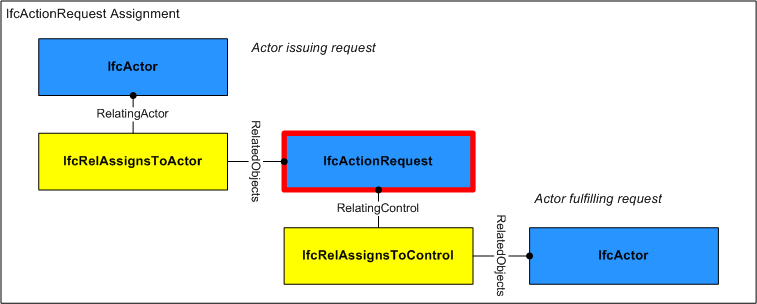 | Figure 1 — Action request assignment |
|
| Field | Mapping | Definition |
|---|
| (Query) | \IfcBeamStandardCase
| |
|---|
| Material Profile Set Usage | \IfcProduct.HasAssociations[*]
\IfcRelAssociatesMaterial.RelatingMaterial
\IfcMaterialProfileSetUsage.ForProfileSet
\IfcMaterialProfileSet.MaterialProfiles[*]
\IfcMaterialProfile.Name
| The IfcBeamStandardCase defines in addition that the IfcBeamType should have a unique IfcMaterialProfileSet, that is referenced by the IfcMaterialProfileSetUsage that is assigned to all occurrences of this IfcBeamType.
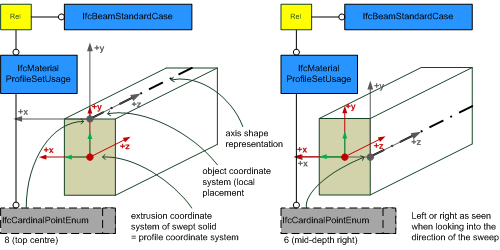 |
<blockquote class="example">EXAMPLE Figure 2 illustrates alignment of cardinal points.</blockquote>
NOTE It has to be guaranteed that the use of IfcCardinalPointEnum is consistent to the placement of the extrusion body provided by IfcExtrudedAreaSolid.Position
NOTE The cardinal points 8 (top centre) and 6 (mid-depth right) are assigned according to the definition at IfcCardinalPointReference |
Figure 2 — Beam cardinal points |
|
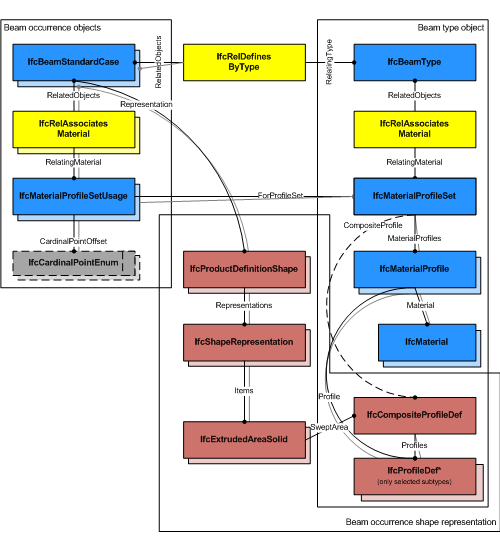 |
EXAMPLE Figure 3 illustrates assignment of a composite profile by using IfcCompositeProfile for geometric representation and several IfcMaterialProfile's within the IfcMaterialProfileSet.
|
Figure 3 — Beam composite profiles |
|
| Placement | \IfcProduct.ObjectPlacement
\IfcLocalPlacement.RelativePlacement
\IfcAxis2Placement3D
| The following restriction is imposed:
- The local placement shall provide the location and directions for the standard beam, the x/y plane is the plane for the start profile, and the z-axis is the extrusion axis for the beam body (in case of rotation, the tangent direction).
|
| Axis 3D Geometry | \IfcElement.Representation
\IfcProductDefinitionShape.Representations['Axis']
\IfcShapeRepresentation.ContextOfItems
\IfcGeometricRepresentationContext
| The following additional constraints apply to the 'Axis' representation, if the 'Body' shape representation has the RepresentationType : 'SweptSolid':
 |
EXAMPLE As shown in Figure 76, the axis shall be defined along the z axis of the object coordinate system. The axis representation can be used to represent the system length of a beam that may extent the body length of the beam.
|
Figure 1 — Beam axis representation | |
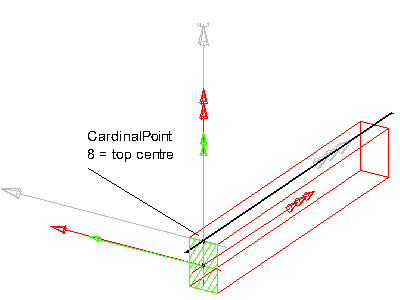 |
EXAMPLE As shown in Figure 77, the axis representation shall be used to represent the cardinal point as the offset between the 'Axis' and the extrusion path of the beam. The extrusion path is provided as IfcExtrudedAreaSolid.ExtrudedDirection and should be parallel to the 'Axis' and the z axis. It has to be guaranteed that the value provided by
IfcMaterialProfileSetUsage.CardinalPoint is consistent to the IfcExtrudedAreaSolid.Position.
|
Figure 2 — Beam axis cardinal point | |
|
| Body SweptSolid Geometry | \IfcElement.Representation
\IfcProductDefinitionShape.Representations[*]
\IfcShapeRepresentation.ContextOfItems
\IfcGeometricRepresentationContext
| The following additional constraints apply to the 'SweptSolid' representation:
- Solid: IfcExtrudedAreaSolid, IfcRevolvedAreaSolid shall be supported
- Solid Position : The IfcSweptAreaSolid.Position shall exclusively been used to correspond to the cardinal point. The x/y offset of the Position represents the cardinal point offset of the profile against the axis. No rotation shall be allowed.
- Profile: All subtypes of IfcParameterizedProfileDef
- Profile Position : For all single profiles, the IfcParameterizedProfileDef.Position shall be NIL, or having Location = 0.,0. and RefDirection = 1.,0.
- Extrusion: Perpendicular to the profile direction. The IfcExtrudedAreaSolid.ExtrudedDirection shall be [0.,0.,1.].
- Orientation: The y-axis of the profile, as determined by IfcSweptAreaSolid.Position.P[2] shall point upwards. It indicates the "role" of the beam, a role=0° means y-axis of profile pointing upwards.
Figure 1 illustrates a standard geometric representation with cardinal point applied as 1 (bottom left).
The following interpretation of dimension parameter applies for rectangular beams with linear extrusions:
- IfcRectangleProfileDef.YDim interpreted as beam height
- IfcRectangleProfileDef.XDim interpreted as beam width
The following interpretation of dimension parameter applies for circular beams:
- IfcCircleProfileDef.Radius interpreted as beam radius.
 | Figure 1 — Beam body extrusion |
|
| Body AdvancedSweptSolid Geometry | \IfcElement.Representation
\IfcProductDefinitionShape.Representations[*]
\IfcShapeRepresentation.ContextOfItems
\IfcGeometricRepresentationContext
| The following additional constraints apply to the 'AdvancedSweptSolid' representation type:
NOTE View definitions and implementer agreement can further constrain the allowed swept solid types.
- Solid Position : see 'SweptSolid' geometric representation
- Profile: see 'SweptSolid' geometric representation
- Profile Position : see 'SweptSolid' geometric representation
- Extrusion: not applicable
|
| Body Clipping Geometry | \IfcElement.Representation
\IfcProductDefinitionShape.Representations[*]
\IfcShapeRepresentation.ContextOfItems
\IfcGeometricRepresentationContext
| The following constraints apply to the 'Clipping' representation:
- Solid : see 'SweptSolid' geometric representation
- Solid Position : see 'SweptSolid' geometric representation
- Profile : see 'SweptSolid' geometric representation
- Profile Position : see 'SweptSolid' geometric representation
- Extrusion : see 'SweptSolid' geometric representation
- Orientation : see 'SweptSolid' geometric representation
- Boolean result: The IfcBooleanClippingResult shall be supported, allowing for Boolean differences between the swept solid (here IfcExtrudedAreaSolid) and one or several IfcHalfSpaceSolid (or its subtypes).
Figure 1 illustrates a 'Clipping' geometric representation with use of IfcBooleanClippingResult between an IfcExtrudedAreaSolid and an IfcHalfSpaceSolid to create a clipped body, with cardinal point applied as 4 (mid-depth left)
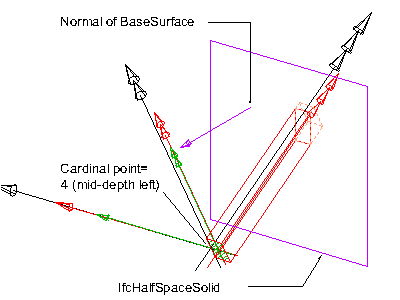 | Figure 1 — Beam body clipping |
|
| Field | Mapping | Definition |
|---|
| (Query) | \IfcBridge
| |
|---|
| Spatial Composition | \IfcSpatialElement.Decomposes[*]
\IfcRelAggregates.RelatingObject
\IfcProject.Name
|
NOTE By using the inverse relationship IfcBridge.Decomposes it references IfcProject || IfcSite || IfcBridge through IfcRelAggregates.RelatingObject. If it refers to another instance of IfcBridge, the referenced IfcBridge needs to have a different and higher CompositionType, i.e. COMPLEX (if the other IfcBuilding has ELEMENT), or ELEMENT (if the other IfcBridge has PARTIAL).
|
| Spatial Decomposition | \IfcObjectDefinition.IsDecomposedBy[*]
\IfcRelAggregates.RelatedObjects[*]
\IfcSpatialElement.Name
\IfcLabel
|
NOTE By using the inverse relationship IfcBridge.IsDecomposedBy it references IfcBridge || IfcBridgePart through IfcRelAggregates.RelatedObjects. If it refers to another instance of IfcBridge, the referenced IfcBridge needs to have a different and lower CompositionType, i.e. ELEMENT (if the other IfcBridge has COMPLEX), or PARTIAL (if the other IfcBridge has ELEMENT).
|
| Spatial Container | \IfcSpatialElement.ContainsElements[*]
\IfcRelContainedInSpatialStructure.RelatedElements[*]
\IfcProduct
|
NOTE If there are building elements and/or other elements directly related to the IfcBridge, they are associated with the IfcBridge by using the objectified relationship IfcRelContainedInSpatialStructure. The IfcBridge references them by its inverse relationship: > * IfcBridge.ContainsElements -- referencing any subtype of IfcProduct (with the exception of other spatial structure element) by IfcRelContainedInSpatialStructure.RelatedElements.
|
| Bridge Systems | \IfcSpatialElement.ServicedBySystems[*]
\IfcRelServicesBuildings.RelatingSystem
\IfcSystem.Name
\IfcLabel
| Optional name for use by the participating software systems or users. For some subtypes of IfcRoot the insertion of the Name attribute may be required. This would be enforced by a where rule. |
| Property Sets for Objects | \IfcObject
| The IFC class identifier indicating the subtype of object. |
| \IfcObject.ObjectType
\IfcLabel
| The type denotes a particular type that indicates the object further. The use has to be established at the level of instantiable subtypes. In particular it holds the user defined type, if the enumeration of the attribute _PredefinedType_ is set to USERDEFINED. |
| Placement | \IfcProduct.ObjectPlacement
\IfcLocalPlacement.RelativePlacement
\IfcAxis2Placement3D
| The local placement for IfcBridge is defined in its supertype IfcProduct. It is defined by IfcLocalPlacement or by IfcLinearPlacement>/em> which defines the local coordinate
system that is referenced by all geometric representations.
- The PlacementRelTo relationship of IfcLocalPlacement shall point (if relative placement is used) to the IfcSpatialStructureElement of type IfcSite, or of type IfcBuilding (e.g. to position a building relative to a building complex, or a building section to a building).
- If the relative placement is not used, the absolute placement is defined within the world coordinate system.
|
| Property Sets for Objects | \IfcObject
| The IFC class identifier indicating the subtype of object. |
| Body Geometry | \IfcElement.Representation
\IfcProductDefinitionShape.Representations['Body']
\IfcShapeRepresentation.ContextOfItems
\IfcGeometricRepresentationContext
| The body (or solid model) geometric representation (if the bridge has an independent geometric representation) of IfcBridge is defined using faceted B-Rep capabilities (with or without voids), based on the IfcFacetedBrep or on the IfcFacetedBrepWithVoids. In the case of alignment based infrastructure, the geometric representation can be defined using IfcSectionedSolidHorizontal optionally IfcSweptAreaSolid.
NOTE Since the bridge shape is usually described by the exterior building elements, an independent shape representation shall only be given, if the bridge is exposed independently from its constituting elements and such independent geometric representation may be prohibited in model view definitions.
|
| Field | Mapping | Definition |
|---|
| (Query) | \IfcBridgePart
| |
|---|
| Spatial Composition | \IfcSpatialElement.Decomposes[*]
\IfcRelAggregates.RelatingObject
\IfcProject.Name
|
NOTE By using the inverse relationship IfcBridgePart.Decomposes it references (IfcBridge || IfcBridgePart) through IfcRelAggregates.RelatingObject_IfcBridgePart, the referenced
IfcBridgePart needs to have a different and higher
CompositionType, i.e. COMPLEX (if the other IfcBridgePart has ELEMENT), or ELEMENT (if the other
IfcBridgePart has PARTIAL)._
|
| Spatial Decomposition | \IfcObjectDefinition.IsDecomposedBy[*]
\IfcRelAggregates.RelatedObjects[*]
\IfcSpatialElement.Name
\IfcLabel
|
NOTE By using the inverse relationship IfcBridgePart.IsDecomposedBy it references IfcBridgePart through IfcRelAggregates.RelatedObjects. If it refers to another instance of IfcBridgePart, the referenced IfcBridgePart needs to have a different and lower CompositionType, i.e. ELEMENT (if the other IfcBuildingStorey has COMPLEX), or PARTIAL (if the other IfcBuildingStorey has ELEMENT).
NOTE Multi storey spaces shall be spatially contained by only a single building storey, usually it is the building storey where the base of the space lies.
|
| Spatial Container | \IfcSpatialElement.ContainsElements[*]
\IfcRelContainedInSpatialStructure.RelatedElements[*]
\IfcProduct
| If there are building elements and/or other elements directly related to the IfcBridgePart (like most building elements, such as walls, columns, etc.), they are associated with the IfcBridgePart by using the objectified relationship IfcRelContainedInSpatialStructure. The IfcBridgePart references them by its inverse relationship:
- IfcBridgePart.ContainsElements -- referencing any subtype of IfcProduct (with the exception of other spatial structure element) by IfcRelContainedInSpatialStructure.RelatedElements.
Elements can also be referenced in an IfcBridgePart, for example, if they span through several storeys. This is expressed by using the objectified relationship IfcRelReferencedInSpatialStructure. Systems, such as building service or electrical distribution systems, zonal systems, or structural analysis systems, relate to IfcBridgePart by using the objectified relationship IfcRelServicesBuildings.
|
| \IfcObject.ObjectType
\IfcLabel
| The type denotes a particular type that indicates the object further. The use has to be established at the level of instantiable subtypes. In particular it holds the user defined type, if the enumeration of the attribute _PredefinedType_ is set to USERDEFINED. |
| Placement | \IfcProduct.ObjectPlacement
\IfcLocalPlacement.RelativePlacement
\IfcAxis2Placement3D
| The local placement for IfcBridgePart is defined in its supertype IfcProduct. It is defined by the IfcLocalPlacement or IfcLinearPlacement, which defines the local coordinate system that is referenced by all geometric representations.
- The PlacementRelTo relationship of IfcLocalPlacement or IfcLinearPlacement shall point (if relative placement is used) to the IfcSpatialStructureElement of type IfcBridge, or of type IfcBridgePart (e.g. to position a bridge part relative to a bridge part complex, or a partial bridge part to a bridge part).
- If the relative placement is not used, the absolute placement is defined within the world coordinate system.
|
| Body Geometry | \IfcElement.Representation
\IfcProductDefinitionShape.Representations['Body']
\IfcShapeRepresentation.ContextOfItems
\IfcGeometricRepresentationContext
| The body (or solid model) geometric representation (if the bridge part has an independent geometric representation) of IfcBridgePart is defined using faceted B-Rep capabilities (with or without voids), based on the IfcFacetedBrep or on the IfcFacetedBrepWithVoids. In the case of alignment based infrastructure, the geometric representation can be defined using IfcSectionedSolidHorizontal optionally IfcSweptAreaSolid.
NOTE Since the bridge part shape is usually described by the exterior building elements, an independent shape representation shall only be given, if the bridge part is exposed independently from its constituting elements and such independent geometric representation may be prohibited in model view definitions.
|
| Field | Mapping | Definition |
|---|
| (Query) | \IfcBuilding
| |
|---|
| Spatial Composition | \IfcSpatialElement.Decomposes[*]
\IfcRelAggregates.RelatingObject
\IfcProject.Name
|
NOTE By using the inverse relationship IfcBuilding.Decomposes it references IfcProject || IfcSite || IfcBuilding through IfcRelAggregates.RelatingObject. If it refers to another instance of IfcBuilding, the referenced IfcBuilding needs to have a different and higher CompositionType, i.e. COMPLEX (if the other IfcBuilding has ELEMENT), or ELEMENT (if the other IfcBuilding has PARTIAL).
|
| Spatial Decomposition | \IfcObjectDefinition.IsDecomposedBy[*]
\IfcRelAggregates.RelatedObjects[*]
\IfcSpatialElement.Name
\IfcLabel
|
NOTE By using the inverse relationship IfcBuilding.IsDecomposedBy it references IfcBuilding || IfcBuildingStorey through IfcRelAggregates.RelatedObjects. If it refers to another instance of IfcBuilding, the referenced IfcBuilding needs to have a different and lower CompositionType, i.e. ELEMENT (if the other IfcBuilding has COMPLEX), or PARTIAL (if the other IfcBuilding has ELEMENT).
|
| Spatial Container | \IfcSpatialElement.ContainsElements[*]
\IfcRelContainedInSpatialStructure.RelatedElements[*]
\IfcProduct
|
NOTE If there are building elements and/or other elements directly related to the IfcBuilding (like a curtain wall spanning several stories), they are associated with the IfcBuilding by using the objectified relationship IfcRelContainedInSpatialStructure. The IfcBuilding references them by its inverse relationship: > * IfcBuilding.ContainsElements -- referencing any subtype of IfcProduct (with the exception of other spatial structure element) by IfcRelContainedInSpatialStructure.RelatedElements.
|
| \IfcObject
| The IFC class identifier indicating the subtype of object. |
| Quantity Sets | \IfcObject.IsDefinedBy[*]
\IfcRelDefinesByProperties.RelatingPropertyDefinition
\IfcElementQuantity.Name
\IfcLabel
| Optional name for use by the participating software systems or users. For some subtypes of IfcRoot the insertion of the Name attribute may be required. This would be enforced by a where rule. |
| Placement | \IfcProduct.ObjectPlacement
\IfcLocalPlacement.RelativePlacement
\IfcAxis2Placement3D
| The local placement for IfcBuilding is defined in its supertype IfcProduct. It is defined by the IfcLocalPlacement, which defines the local coordinate system that is referenced by all geometric representations.
- The PlacementRelTo relationship of IfcLocalPlacement shall point (if relative placement is used) to the IfcSpatialStructureElement of type IfcSite, or of type IfcBuilding (e.g. to position a building relative to a building complex, or a building section to a building).
- If the relative placement is not used, the absolute placement is defined within the world coordinate system.
|
| FootPrint GeomSet Geometry | \IfcProduct.Representation
\IfcProductDefinitionShape.Representations[*]
\IfcShapeRepresentation.RepresentationIdentifier
\IfcLabel
| The foot print representation of IfcBuilding is given by either a single 2D curve (such as IfcPolyline or IfcCompositeCurve), or by a list of 2D curves (in case of inner boundaries), if the building has an independent geometric representation.
NOTE The independent geometric representation of IfcBuilding may not be allowed in certain model view definitions. In those cases only the contained elements and spaces have an independent geometric representation.
|
| Body Geometry | \IfcElement.Representation
\IfcProductDefinitionShape.Representations['Body']
\IfcShapeRepresentation.ContextOfItems
\IfcGeometricRepresentationContext
| The body (or solid model) geometric representation (if the building has an independent geometric representation) of IfcBuilding is defined using faceted B-Rep capabilities (with or without voids), based on the IfcFacetedBrep or on the IfcFacetedBrepWithVoids.
NOTE Since the building shape is usually described by the exterior building elements, an independent shape representation shall only be given, if the building is exposed independently from its constituting elements and such independent geometric representation may be prohibited in model view definitions.
|
| Field | Mapping | Definition |
|---|
| (Query) | \IfcBuildingStorey
| |
|---|
| Spatial Composition | \IfcSpatialElement.Decomposes[*]
\IfcRelAggregates.RelatingObject
\IfcProject.Name
|
NOTE By using the inverse relationship IfcBuildingStorey.Decomposes it references (IfcBuilding || IfcBuildingStorey) through IfcRelAggregates.RelatingObject_IfcBuildingStorey, the referenced
IfcBuildingStorey needs to have a different and higher
CompositionType, i.e. COMPLEX (if the other IfcBuildingStorey has ELEMENT), or ELEMENT (if the other
IfcBuildingStorey has PARTIAL)._
|
| Spatial Decomposition | \IfcObjectDefinition.IsDecomposedBy[*]
\IfcRelAggregates.RelatedObjects[*]
\IfcSpatialElement.Name
\IfcLabel
|
NOTE By using the inverse relationship IfcBuildingStorey.IsDecomposedBy it references IfcBuildingStorey || IfcSpace through IfcRelAggregates.RelatedObjects. If it refers to another instance of IfcBuildingStorey, the referenced IfcBuildingStorey needs to have a different and lower CompositionType, i.e. ELEMENT (if the other IfcBuildingStorey has COMPLEX), or PARTIAL (if the other IfcBuildingStorey has ELEMENT).
NOTE Multi storey spaces shall be spatially contained by only a single building storey, usually it is the building storey where the base of the space lies.
|
| Spatial Container | \IfcSpatialElement.ContainsElements[*]
\IfcRelContainedInSpatialStructure.RelatedElements[*]
\IfcProduct
| If there are building elements and/or other elements directly related to the IfcBuildingStorey (like most building elements, such as walls, columns, etc.), they are associated with the IfcBuildingStorey by using the objectified relationship IfcRelContainedInSpatialStructure. The IfcBuildingStorey references them by its inverse relationship:
- IfcBuildingStorey.ContainsElements -- referencing any subtype of IfcProduct (with the exception of other spatial structure element) by IfcRelContainedInSpatialStructure.RelatedElements.
Elements can also be referenced in an IfcBuildingStorey, for example, if they span through several storeys. This is expressed by using the objectified relationship IfcRelReferencedInSpatialStructure. Systems, such as building service or electrical distribution systems, zonal systems, or structural analysis systems, relate to IfcBuildingStorey by using the objectified relationship IfcRelServicesBuildings.
|
| \IfcObject
| The IFC class identifier indicating the subtype of object. |
| \IfcObject.IsDefinedBy[*]
\IfcRelDefinesByProperties.RelatingPropertyDefinition
\IfcElementQuantity.Name
\IfcLabel
| Optional name for use by the participating software systems or users. For some subtypes of IfcRoot the insertion of the Name attribute may be required. This would be enforced by a where rule. |
| Placement | \IfcProduct.ObjectPlacement
\IfcLocalPlacement.RelativePlacement
\IfcAxis2Placement3D
| The local placement for IfcBuildingStorey is defined in its supertype IfcProduct. It is defined by the IfcLocalPlacement, which defines the local coordinate system that is referenced by all geometric representations.
- The PlacementRelTo relationship of IfcLocalPlacement shall point (if relative placement is used) to the IfcSpatialStructureElement of type IfcBuilding, or of type IfcBuildingStorey (e.g. to position a building storey relative to a building storey complex, or a partial building storey to a building storey).
- If the relative placement is not used, the absolute placement is defined within the world coordinate system.
|
| FootPrint GeomSet Geometry | \IfcProduct.Representation
\IfcProductDefinitionShape.Representations[*]
\IfcShapeRepresentation.RepresentationIdentifier
\IfcLabel
| The foot print representation of IfcBuildingStorey is given by either a single 2D curve (such as IfcPolyline or IfcCompositeCurve), or by a list of 2D curves (in case of inner boundaries), if the building storey has an independent geometric representation.
NOTE The independent geometric representation of IfcBuildingStorey may not be allowed in certain model view definitions. In those cases only the contained elements and spaces have an independent geometric representation.
|
| Body Geometry | \IfcElement.Representation
\IfcProductDefinitionShape.Representations['Body']
\IfcShapeRepresentation.ContextOfItems
\IfcGeometricRepresentationContext
| The body (or solid model) geometric representation (if the building storey has an independent geometric representation) of IfcBuildingStorey is defined using faceted B-Rep capabilities (with or without voids), based on the IfcFacetedBrep or on the IfcFacetedBrepWithVoids.
NOTE Since the building storey shape is usually described by the exterior building elements, an independent shape representation shall only be given, if the building storey is exposed independently from its constituting elements and such independent geometric representation may be prohibited in model view definitions.
|
| Field | Mapping | Definition |
|---|
| (Query) | \IfcCivilElement
| |
|---|
| Object Typing | \IfcObject.IsTypedBy[*]
\IfcRelDefinesByType.RelatingType
\IfcTypeObject.Name
| Optional name for use by the participating software systems or users. For some subtypes of IfcRoot the insertion of the Name attribute may be required. This would be enforced by a where rule. |
| Property Sets | \IfcObject
| The IFC class identifier indicating the subtype of object. |
| Spatial Containment | \IfcElement.ContainedInStructure[*]
\IfcRelContainedInSpatialStructure.RelatingStructure
\IfcSpatialElement.Name
\IfcLabel
| Optional name for use by the participating software systems or users. For some subtypes of IfcRoot the insertion of the Name attribute may be required. This would be enforced by a where rule. |
| Classification | \IfcObjectDefinition.HasAssociations[*]
\IfcRelAssociatesClassification.RelatingClassification
\IfcClassificationReference.Identification
\IfcIdentifier
| The _Identification_ provides a unique identifier of the referenced item within the external source (classification, document or library). It may be provided as
* a key, e.g. a classification notation, like NF2.3
* a handle
* a uuid or guid
It may be human readable (such as a key) or not (such as a handle or uuid) depending on the context of its usage (which has to be determined by local agreement).
{ .change-ifc2x4}
> IFC4 CHANGE Attribute renamed from _ItemReference_ for consistency.
> |
| Field | Mapping | Definition |
|---|
| (Query) | \IfcColumnStandardCase
| |
|---|
| Material Profile Set Usage | \IfcProduct.HasAssociations[*]
\IfcRelAssociatesMaterial.RelatingMaterial
\IfcMaterialProfileSetUsage.ForProfileSet
\IfcMaterialProfileSet.MaterialProfiles[*]
\IfcMaterialProfile.Name
| The IfcColumnStandardCase defines in addition that the IfcColumnType should have a unique IfcMaterialProfileSet, that is referenced by the IfcMaterialProfileSetUsage assigned to all occurrences of this IfcColumnType. Composite profile columns can be represented by refering to several IfcMaterialProfile's within the IfcMaterialProfileSet that is referenced from the IfcMaterialProfileSetUsage.
Figure 1 illustrates assignment of IfcMaterialProfileSetUsage and IfcMaterialProfileSet to the IfcColumnStandardCase as the column occurrence and to the IfcColumnType. The same IfcMaterialProfileSet shall be shared by many occurrences of IfcMaterialProfileSetUsage. This relationship shall be consistent to the relationship between the IfcColumnType and the IfcColumnStandardCase.
 | Figure 1 — Column profile usage |
Figure 2 illustrates cardinal point alignment.
NOTE It has to be guaranteed that the use of IfcCardinalPointEnum is consistent to the placement of the extrusion body provided by IfcExtrudedAreaSolid.Position
NOTE The cardinal points 7 (top left), and 6 (mid-depth right) are assigned according to the definition at IfcCardinalPointReference
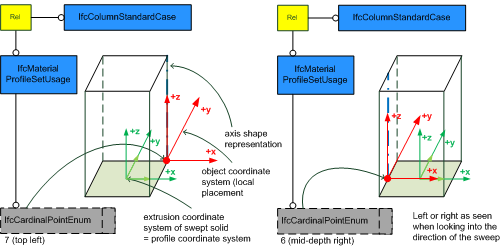 | Figure 2 — Column cardinal points |
Figure 3 illustrates assignment of a composite profile by using IfcCompositeProfile for geometric representation and several IfcMaterialProfile's within the IfcMaterialProfileSet. The number of IfcMaterialProfile's within the IfcMaterialProfileSet is restricted to maximal 2 and requires the use of IfcExtrudedAreaSolidTapered, or IfcRevolvedAreaSolidTapered for the correct 'Body' shape representation.
 | Figure 3 — Column composite profiles |
|
| Product Placement | \IfcProduct.ObjectPlacement
\IfcLocalPlacement.RelativePlacement
\IfcAxis2Placement3D
| The following restriction is imposed:
- The local placement shall provide the location and directions for the standard column, the x/y plane is the plane for the start profile, and the z-axis is the extrusion axis for the column body (in case of rotation, the tangent direction).
|
| Axis 3D Geometry | \IfcElement.Representation
\IfcProductDefinitionShape.Representations['Axis']
\IfcShapeRepresentation.ContextOfItems
\IfcGeometricRepresentationContext
| The following additional constraints apply to the 'Axis' representation, if the 'Body' shape representation has the RepresentationType : 'SweptSolid':
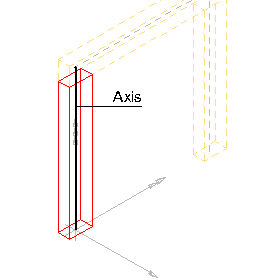 |
EXAMPLE As shown in Figure 1, the axis shall be defined along the z axis of
the object coordinate system. The axis representation can be used to
represent the system length of a column that may extent the body
length of the column.
|
Figure 1 — Column axis representation |
|
 |
EXAMPLE As shown in Figure 2, the axis representation shall be used to represent the cardinal point as the offset between the 'Axis' and the extrusion path of the column. The extrusion path is provided as IfcExtrudedAreaSolid.ExtrudedDirection and should be parallel to the 'Axis'. It has to be guaranteed that the value provided by IfcMaterialProfileSetUsage.CardinalPoint is consistent to the IfcExtrudedAreaSolid.Position.
|
Figure 2 — Column axis cardinal point |
|
|
| Body SweptSolid Geometry | \IfcElement.Representation
\IfcProductDefinitionShape.Representations[*]
\IfcShapeRepresentation.ContextOfItems
\IfcGeometricRepresentationContext
| The following additional constraints apply to the 'SweptSolid' representation:
- Solid: IfcExtrudedAreaSolid, IfcRevolvedAreaSolid shall be supported
- Profile: all subtypes of IfcProfileDef (with exception of IfcArbitraryOpenProfileDef)
- Profile Position : For all single profiles, the IfcParameterizedProfileDef.Position shall be NIL, or having Location = 0.,0. and RefDirection = 1.,0.
- Extrusion: perpendicular to the profile direction. The IfcExtrudedAreaSolid.ExtrudedDirection shall be [0.,0.,1.].
- Orientation: The y-axis of the profile, as determined by IfcSweptAreaSolid.Position.P[2] shall point to the Y-Axis. It indicates the "role" of the column, a role=0° means y-axis of profile = Y-axis of reference coordinate system.
Figure 1 illustrates a standard geometric representation with cardinal point applied as 5 (mid-depth centre).
The following interpretation of dimension parameter applies for rectangular columns:
- IfcRectangleProfileDef.YDim interpreted as column width
- IfcRectangleProfileDef.XDim interpreted as column depth
The following interpretation of dimension parameter applies for circular columns:
- IfcCircleProfileDef.Radius interpreted as column radius.
 | Figure 1 — Column body extrusion |
|
| Body AdvancedSweptSolid Geometry | \IfcElement.Representation
\IfcProductDefinitionShape.Representations[*]
\IfcShapeRepresentation.ContextOfItems
\IfcGeometricRepresentationContext
| The following additional constraints apply to the 'AdvancedSweptSolid' representation type:
NOTE View definitions and implementer agreement can further constrain the allowed swept solid types.
- Profile: see 'SweptSolid' geometric representation
- Profile Position : see 'SweptSolid' geometric representation
- Extrusion: not applicable
|
| Body Clipping Geometry | \IfcElement.Representation
\IfcProductDefinitionShape.Representations[*]
\IfcShapeRepresentation.ContextOfItems
\IfcGeometricRepresentationContext
| The following constraints apply to the 'Clipping' representation:
- Solid: see 'SweptSolid' geometric representation
- Profile: see 'SweptSolid' geometric representation
- Profile Position : see 'SweptSolid' geometric representation
- Extrusion: see 'SweptSolid' geometric representation
- Orientation: see 'SweptSolid' geometric representation
- Boolean result: The IfcBooleanClippingResult shall be supported, allowing for Boolean differences between the swept solid (here IfcExtrudedAreaSolid) and one or several IfcHalfSpaceSolid (or its subtypes).
Figure 1 illustrates a 'Clipping' geometric representation with use of IfcBooleanClippingResult between an IfcExtrudedAreaSolid and an IfcHalfSpaceSolid to create a clipped body, with cardinal point applied as 2 (bottom centre).
 | Figure 1 — Column body clipping |
|
| Field | Mapping | Definition |
|---|
| (Query) | \IfcConstructionResource
| |
|---|
| Document | \IfcObjectDefinition.HasAssociations[*]
\IfcRelAssociatesDocument.Name
\IfcLabel
| Documents may be published for work plans consisting of schedules, calendars, tasks, and resources. The relationship IfcRelAssociatesDocument may be used to preserve mappings to such document where RelatingDocument points to an IfcDocumentReference and RelatedObjects includes the IfcConstructionResource as shown in Figure 184. IfcDocumentReference.ItemReference identifies the resource within the scope of the document, such as an integer or guid. The IfcDocumentReference.ReferencedDocument corresponds to the document which is uniquely identified by IfcDocumentInformation.DocumentId and/or IfcDocumentInformation.PublicationLocation. Such document mapping allows items in the document to be updated from the building information model and vice-versa.
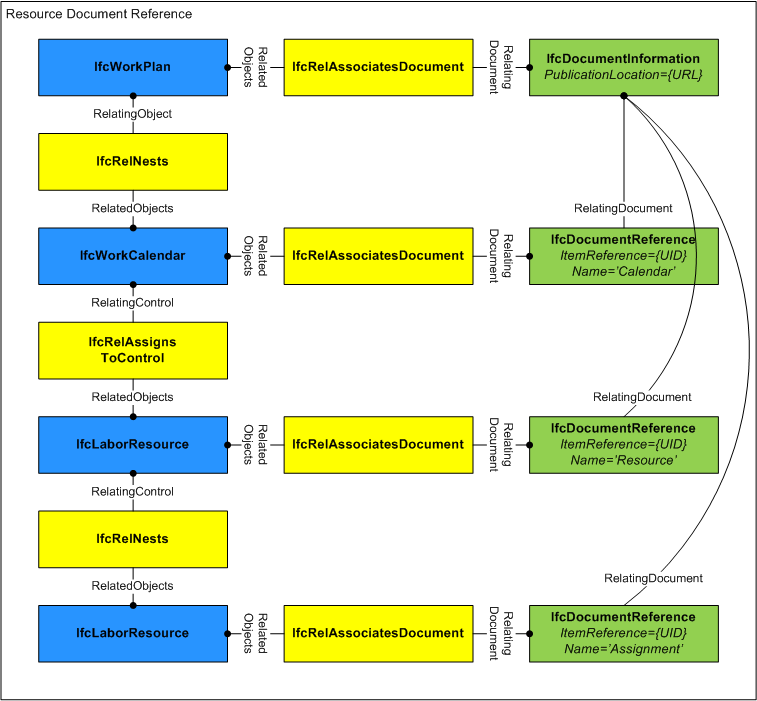 | Figure 1 — Construction resource document use |
|
| Constraint | \IfcObjectDefinition.HasAssociations[*]
\IfcRelAssociatesConstraint.RelatingConstraint
\IfcObjective.BenchmarkValues[*]
\IfcMetric.DataValue
\IfcMetricValueSelect
| Constraints may be applied to a resource to indicate fixed work (such as total person-hours) or fixed usage (such as simultaneous workers).
|
| Object Typing | \IfcObject.IsTypedBy[*]
\IfcRelDefinesByType.RelatingType
\IfcTypeObject.Name
| The resource type may provide shared productivity and cost information, allowing tasks and resources to be selected according to lowest cost and/or shortest duration. Given an IfcProduct of a particular IfcTypeProduct type, an IfcTypeProcess may be selected from those assigned to the product type using IfcRelAssignsToProduct, and an IfcTypeResource may be selected from those assigned to the process type using IfcRelAssignsToProcess. Then IfcTask and IfcConstructionResource occurrences may be instantiated from the type definitions, applying productivitity and rate information to assigned quantities to calculate ResourceTime.ScheduleWork. Task durations can then be calculated by dividing ResourceTime.ScheduleWork by ResourceTime.ScheduleUsage.
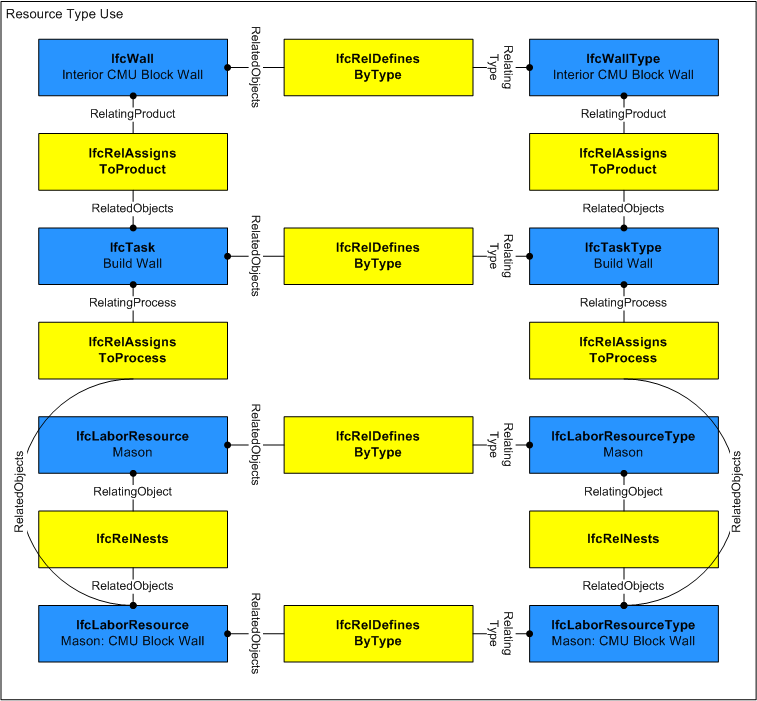 | Figure 1 — Construction resource type use |
|
| \IfcObject
| For time series properties as shown in Figure 180, each IfcTimeSeriesValue indicates a LIST of values, where the sequence of the value corresponds to the IfcCostValue at IfcConstructionResource.CostRatesConsumed. For example, if CostRatesConsumed has two IfcCostValue items in the LIST, "Standard" and "Overtime", then IfcTimeSeriesValue(IfcDuration('T8H0M0S'),IfcDuration('T2H0M0S')) would indicate 8 hours at Standard rate and 2 hours at Overtime rate. If the list of values at IfcTimeSeriesValue.ListValues is less than the size of CostRatesConsumed, then subsequent values are considered to be zero.
 | Figure 1 — Construction resource time series use |
|
| Nesting | \IfcObjectDefinition.IsNestedBy[*]
\IfcRelNests.RelatedObjects[*]
\IfcObject
| Resources may be decomposed into allocation pools using the IfcRelNests relationship as shown in Figure 181. For example, an IfcLaborResource for "Electrician" may be decomposed into three task-specific IfcLaborResource objects: "Electrical Rough-in", "First Floor Circuits", and "Second Floor Circuits". Both relating and related sides may represent the same ResourceTime.ScheduleUsage quantity (for example, 6 workers time-shared), or the related side may break out ResourceTime.ScheduleUsage quantities for reserved use (for example, 4 workers and 2 workers).
A common scenario is two nesting levels where the first-level resources have no task assignments; while second-level resources have specific task assignments indicating that the resource is subdivided into allocations for specific tasks. While the model allows unlimited nesting of resources, implementer agreements may restrict to two nesting levels with task assignments specifically at the second level.
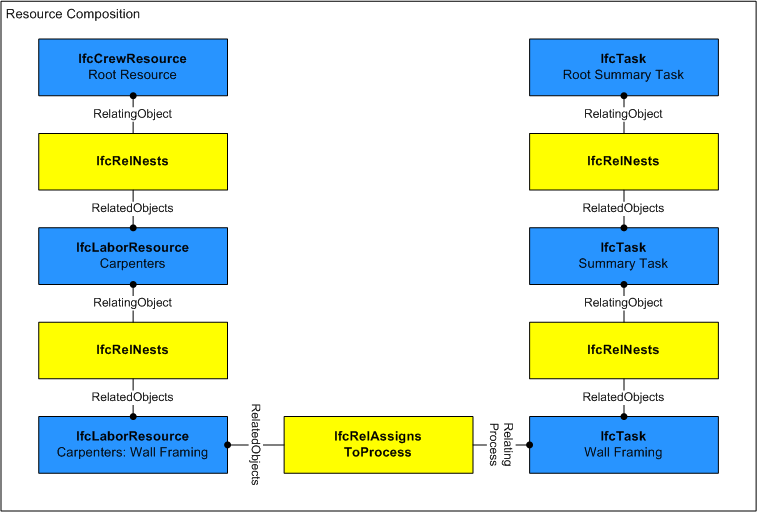 | Figure 1 — Construction resource composition use |
|
| Field | Mapping | Definition |
|---|
| (Query) | \IfcCostItem
| |
|---|
| Classification | \IfcObjectDefinition.HasAssociations[*]
\IfcRelAssociatesClassification.RelatingClassification
\IfcClassificationReference.Identification
\IfcIdentifier
| Instances of IfcCostItem are used for cost estimates, budgets, and other forms, where a variety of identification codes are used extensively to identify the meaning of the cost. Examples include project phase codes, CSI codes, takeoff sequence numbers, and cost accounts. The model allows for all classes that are ultimately subtypes of IfcObject to inherit the ability to have one or more instances of IfcClassificationReference to be assigned. Where identification codes are required, the generic IfcRelAssociatesClassification facility should be used.
|
| Nesting | \IfcObjectDefinition.IsNestedBy[*]
\IfcRelNests.RelatedObjects[*]
\IfcObject
| An IfcCostItem can nest other instances of IfcCostItem through its relationships to IfcRelNests. This can be used to enable the development of complex groups of costs as may be found in cost schedules through to pages, sections and complete cost schedules.
There is always a summary cost item as the root item of the tree representing the cost item nesting. Subsequent instances of IfcCostItem are assigned to the summary cost item using IfcRelNests. The summary cost item itself is assigned to IfcCostSchedule through the IfcRelAssignsToControl relationship.
Figure 1 illustrates a cost item composition used for a cost schedule. Each line item has a quantity and separate unit costs where IfcCostValue.CostType indicates the category of cost. The summary item has a hierarchy of costs calculated according to IfcAppliedValueRelationship.ArithmeticOperator, where IfcCostValue.CostType identifies the category to be totalled. The Tax component has IfcCostValue.CostType set to 'Material' which indicates it is the sum of all nested values of the 'Material' category ($3 x 3000 + $118 x 100 = $20800). The Subtotal component has IfcCostValue.CostType set to an asterisk ('*') which indicates it is the sum of all nested values of all categories.
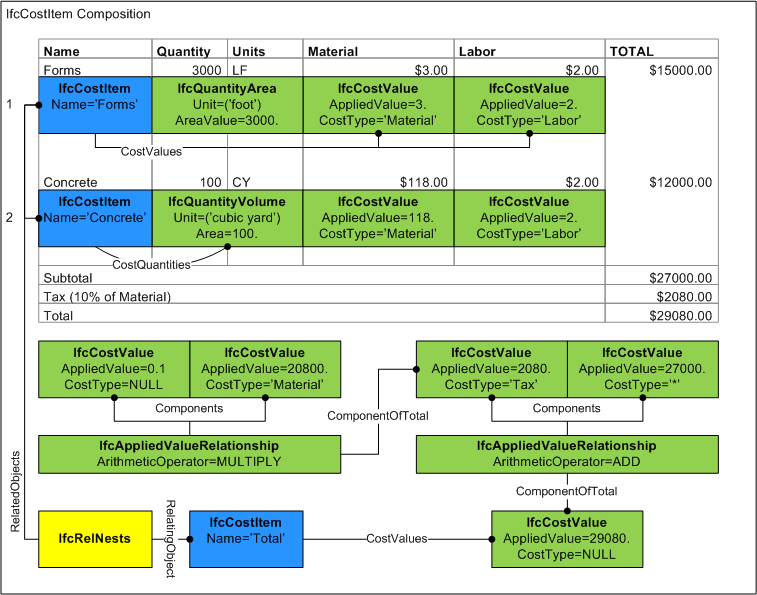 | Figure 1 — Cost composition |
|
| Control Assignment | \IfcControl.Controls[*]
\IfcRelAssignsToControl.RelatedObjects[*]
\IfcObject
| An IfcCostItem can be calculated based on quantities from objects through its relationship to IfcRelAssignsToControl.
For quantity-based costing, IfcElement, IfcTask, or IfcResource occurrence subtypes may be used. Multiple elements may be assigned of the same or different types, using IfcPhysicalQuantity entities defined at each object. Each IfcPhysicalQuantity type must be identical (for example, all values are IfcAreaQuantity) such that they can be added together.
For rate-based costing (specifically for IfcCostScheduleTypeEnum.SCHEDULEOFRATES), a single IfcTypeProduct, IfcTypeProcess, or IfcTypeResource subtype may be used to reflect rates for occurrences of such types. This enables the possibility to generate a quantity-based cost schedule for occurrences based on types with rate-based cost schedules.
IfcRelAssignsToControl is also used in the opposite direction to link the root IfcCostItem to an IfcCostSchedule where RelatingControl is the IfcCostSchedule.
Figure 1 illustrates cost item assignment derived from building elements. The IfcRelAssignsToControl relationship indicates building elements for which quantities are derived. Not shown, costs may also be derived from building elements by traversing assignment relationships from the assigned IfcProduct to IfcProcess to IfcResource, where all costs ultimately originate at resources. It is also possible for cost items to have assignments from processes or resources directly.
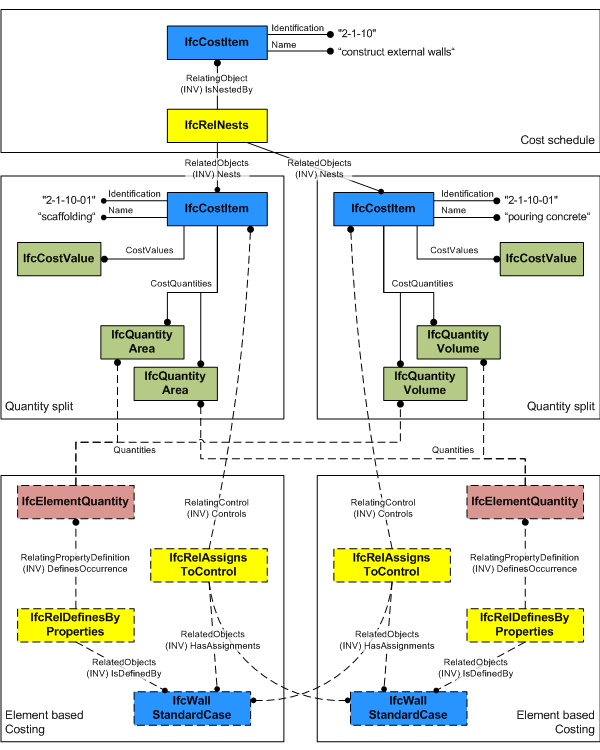 | Figure 1 — Cost assignment |
|
| Field | Mapping | Definition |
|---|
| (Query) | \IfcDistributionFlowElement
| |
|---|
| Object Typing | \IfcObject.IsTypedBy[*]
\IfcRelDefinesByType.RelatingType
\IfcTypeObject.Name
| Optional name for use by the participating software systems or users. For some subtypes of IfcRoot the insertion of the Name attribute may be required. This would be enforced by a where rule. |
| \IfcObject
| The IFC class identifier indicating the subtype of object. |
| Axis Geometry | \IfcElement.Representation
\IfcProductDefinitionShape.Representations['Axis']
\IfcShapeRepresentation.ContextOfItems
\IfcGeometricRepresentationContext
| This represents the 3D flow path of the item having IfcShapeRepresentation.RepresentationType of 'Curve3D' and containing a single IfcBoundedCurve subtype such as IfcPolyline, IfcTrimmedCurve, or IfcCompositeCurve. For elements containing directional ports (IfcDistributionPort with FlowDirection of SOURCE or SINK), the direction of the curve indicates direction of flow where a SINK port is positioned at the start of the curve and a SOURCE port is positioned at the end of the curve. This representation is most applicable to flow segments (pipes, ducts, cables), however may be used at other elements to define a primary flow path if applicable.
|
| Clearance Geometry | \IfcElement.Representation
\IfcProductDefinitionShape.Representations[*]
\IfcShapeRepresentation.ContextOfItems
\IfcGeometricRepresentationContext
| This represents the 3D clearance volume of the item having RepresentationType of 'Surface3D'. Such clearance region indicates space that should not intersect with the 'Body' representation of other elements, though may intersect with the 'Clearance' representation of other elements. The particular use of clearance space may be for safety, maintenance, or other purposes.
|
| Field | Mapping | Definition |
|---|
| (Query) | \IfcDistributionFlowElementType
| |
|---|
| Axis Geometry | \IfcElementType.RepresentationMaps[*]
\IfcRepresentationMap.MappedRepresentation
\IfcShapeRepresentation.ContextOfItems
\IfcGeometricRepresentationContext
| This represents the 3D flow path of the item having IfcShapeRepresentation.RepresentationType of 'Curve3D' and containing a single IfcBoundedCurve subtype such as IfcPolyline, IfcTrimmedCurve, or IfcCompositeCurve. For elements containing directional ports (IfcDistributionPort with FlowDirection of SOURCE or SINK), the direction of the curve indicates direction of flow where a SINK port is positioned at the start of the curve and a SOURCE port is positioned at the end of the curve. This representation is most applicable to flow segment types (pipes, ducts, cables), however may be used at other elements to define a primary flow path if applicable.
If an element type is defined parametrically (such as a flow segment type defining common material profile but no particular length or path), then no representations shall be asserted at the type.
NOTE The product representations are defined as representation maps (at the level of the supertype IfcTypeProduct, which get assigned by an element occurrence instance through the IfcShapeRepresentation.Item[1] being an IfcMappedItem.
|
| Clearance Geometry | \IfcDistributionElementType.RepresentationMaps[*]
\IfcRepresentationMap.MappedRepresentation
\IfcShapeRepresentation.ContextOfItems
\IfcGeometricRepresentationContext
| This represents the 3D clearance volume of the item having RepresentationType of 'Surface3D'. Such clearance region indicates space that should not intersect with the 'Body' representation between element occurrences, though may intersect with the 'Clearance' representation of other element occurrences. The particular use of clearance space may be for safety, maintenance, or other purposes.
|
| Lighting Geometry | \IfcDistributionElementType.RepresentationMaps[*]
\IfcRepresentationMap.MappedRepresentation
\IfcShapeRepresentation.ContextOfItems
\IfcGeometricRepresentationContext
| This represents the light emission of the item having IfcShapeRepresentation.RepresentationType of 'LightSource' and containing one or more IfcLightSource subtypes. This representation is most applicable to lamps and light fixtures, however may be used at other elements that emit light.
|
| Field | Mapping | Definition |
|---|
| (Query) | \IfcDistributionPort
| |
|---|
| Product Local Placement | \IfcProduct.ObjectPlacement
\IfcLocalPlacement.RelativePlacement
\IfcAxis2Placement3D
| The placement of a port indicates the position and orientation of how it may connect to a compatible port on another product. The placement shall be relative to the nesting IfcDistributionElement, IfcDistributionElementType, or enclosing IfcDistributionPort.
The Location is the midpoint of the physical connection, unless otherwise indicated by cardinal point on a material profile.
The Axis points in the direction of the physical connection away from the product if FlowDirection equals SOURCE (or SOURCEANDSINK or NOTDEFINED), or points opposite direction (to the product) if the FlowDirection equals SINK.
NOTE The rationale for positioning the Axis in the direction of flow is to allow for the same geometry to be used, such as for connectors with polarized cross-section.
The RefDirection points in the direction of the local X axis of the material profile, where the local Y axis points up if looking towards the Axis where the local X axis points right.
Upon connecting elements through ports with rigid connections, each object shall be aligned such that the effective Location, Axis, and RefDirection of each port is aligned to be equal (with exception for circular profiles where the RefDirection need not be equal).
|
| \IfcObject
| The IFC class identifier indicating the subtype of object. |
| Port Nesting | \IfcDistributionElement
| Distribution ports are indicated on products and product types using the IfcRelNests relationship where RelatingObject refers to the enclosing IfcDistributionElement or IfcDistributionElementType respectively. The order of ports indicates logical ordering such within outlets, junction boxes, or communications equipment.
Ports may be further nested into sub-ports, for indicating specific connections on components or pins.
|
| Port Connectivity | \IfcDistributionPort.ConnectedTo[*]
\IfcRelConnectsPorts.RelatedPort
\IfcDistributionPort
| IfcDistributionPort may be connected to other objects as follows using the indicated relationship:
- IfcDistributionPort (IfcRelConnectsPorts) : Indicates a connection to another port having the same type and opposite flow direction. For port connections between elements, the RelatingPort is set to a port having FlowDirection=SOURCE and the RelatedPort is set to a port having FlowDirection=SINK. For aggregation scenarios, ports on a device may be mapped to aggregated devices within, in which case ports on the outer device indicate a single FlowDirection but have an additional connection internally to a port on an aggregated inner device. Refer to IfcUnitaryEquipment for an example.
- IfcDistributionElement (through IfcRelConnectsPortToElement): For dynamic ports, indicates the containing element.
Figure 1 illustrates distribution port connectivity.
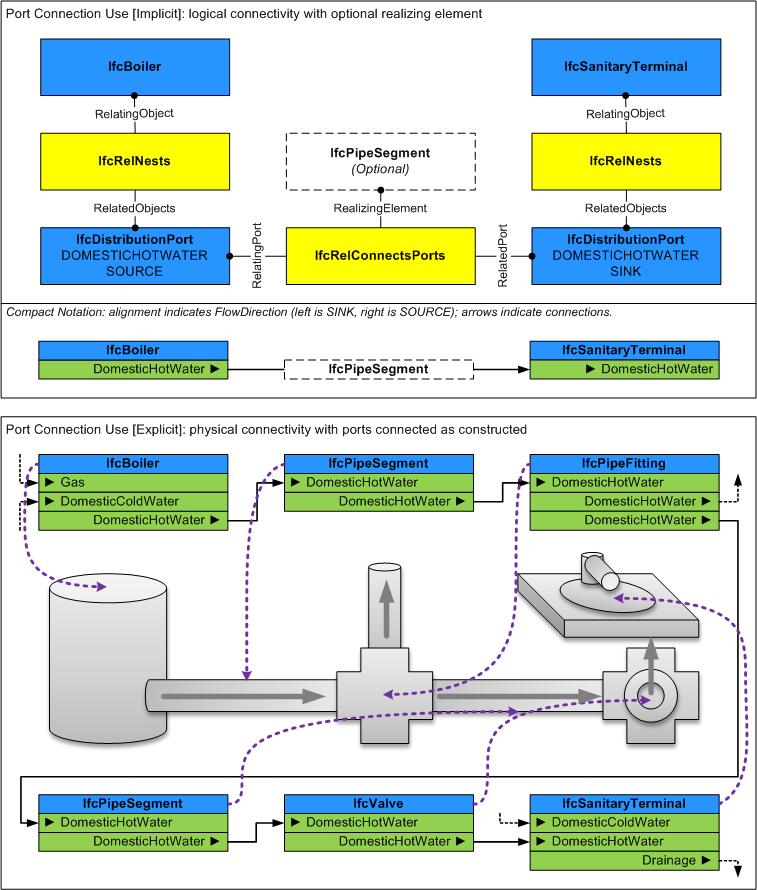 | Figure 1 — Distribution port connectivity |
|
| Product Assignment | \IfcProduct.ReferencedBy[*]
\IfcRelAssignsToProduct.RelatedObjects[*]
\IfcObject
| The IfcDistributionPort may be assigned to the following entities using relationships as indicated:
|
| Field | Mapping | Definition |
|---|
| (Query) | \IfcDoor
| |
|---|
| Door Attributes | \IfcDoor.Tag
\IfcIdentifier
| The opening direction is determined by the local placement of IfcDoor and the OperationType of the IfcDoorType as shown in Figure 1.
NOTE There are different definitions in various countries on what a left opening or left hung or left swing door is (same for right). Therefore the IFC definition may derivate from the local standard and need to be mapped appropriately.
NOTE The OverallWidth and OverallHeight parameters are for informational purpose only.
|
| Object Typing | \IfcObject.IsTypedBy[*]
\IfcRelDefinesByType.RelatingType
\IfcTypeObject.Name
| Optional name for use by the participating software systems or users. For some subtypes of IfcRoot the insertion of the Name attribute may be required. This would be enforced by a where rule. |
| Property Sets for Objects | \IfcObject
| The IFC class identifier indicating the subtype of object. |
| \IfcObject.IsDefinedBy[*]
\IfcRelDefinesByProperties.RelatingPropertyDefinition
\IfcElementQuantity.Name
\IfcLabel
| Optional name for use by the participating software systems or users. For some subtypes of IfcRoot the insertion of the Name attribute may be required. This would be enforced by a where rule. |
| Material Constituent Set | \IfcObjectDefinition.HasAssociations[*]
\IfcRelAssociatesMaterial.RelatingMaterial
\IfcMaterialConstituentSet.MaterialConstituents[*]
\IfcMaterialConstituent.Name
\IfcLabel
| The material of the IfcDoor is defined by the IfcMaterialConstituentSet or as fall back by IfcMaterial and attached by the IfcRelAssociatesMaterial relationship.
|
| Product Local Placement | \IfcProduct.ObjectPlacement
\IfcLocalPlacement.RelativePlacement
\IfcAxis2Placement3D
| The following restriction is imposed:
- The PlacementRelTo relationship of IfcLocalPlacement shall point to the local placement of the same element (if given), in which the IfcDoor is used as a filling (normally an IfcOpeningElement), as provided by the IfcRelFillsElement relationship;
- If the IfcDoor is part of an assembly, e.g. an IfcCurtainWall, then the PlacementRelTo relationship of IfcLocalPlacement shall point (if given) to the local placement of that assembly;
- If the IfcDoor is not inserted into an IfcOpeningElement, then the PlacementRelTo relationship of IfcLocalPlacement shall point (if given) to the local placement of the same IfcSpatialStructureElement that is used in the ContainedInStructure inverse attribute or to a referenced spatial structure element at a higher level.
NOTE The product placement is used to determine the opening direction of the door.
|
| Profile 3D Geometry | \IfcElement.Representation
\IfcProductDefinitionShape.Representations[*]
\IfcShapeRepresentation.ContextOfItems
\IfcGeometricRepresentationContext
| The door profile is represented by a three-dimensional closed curve within a particular shape representation. The profile is used to apply the parameter of the parametric door representation. Only a single closed curve shall be contained in the set of IfcShapeRepresentation.Items.
A 'Profile' representation has to be provided if a parametric representation is applied to the door.
|
| Spatial Containment | \IfcElement.ContainedInStructure[*]
\IfcRelContainedInSpatialStructure.RelatingStructure
\IfcSpatialElement.Name
\IfcLabel
| The IfcDoor, as any subtype of IfcBuildingElement, may participate alternatively in one of the two different containment relationships:
- the Spatial Containment (defined here), or
- the Element Composition.
The IfcDoor may also be connected to the IfcOpeningElement in which it is placed as a filler. In this case, the spatial containment relationship shall be provided, see Figure 1.
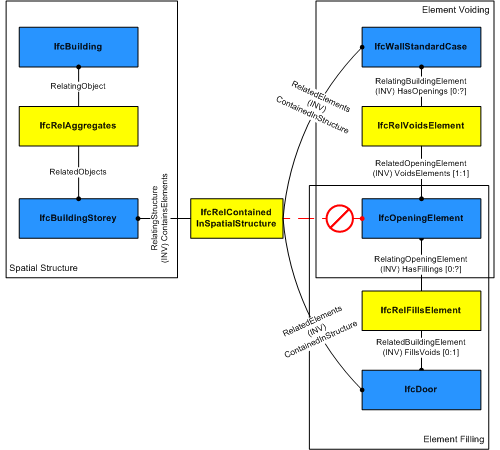 |
NOTE The containment shall be
defined independently of the filling relationship, that is, even if
the IfcDoor is a filling of an opening established by
IfcRelFillsElement, it is also contained in the spatial
structure by
IfcRelContainedInSpatialStructure.
|
|
Figure 1 — Door spatial containment
|
|
|
| Field | Mapping | Definition |
|---|
| (Query) | \IfcElement
| |
|---|
| \IfcObject
| The IFC class identifier indicating the subtype of object. |
| Product Local Placement | \IfcProduct.ObjectPlacement
\IfcLocalPlacement.RelativePlacement
\IfcAxis2Placement3D
| The object placement for any subtype of IfcElement is defined by the IfcObjectPlacement, either IfcLocalPlacement or IfcGridPlacement, which defines the local object coordinate system that is referenced by all geometric representations of that IfcElement.
|
| CoG Geometry | \IfcProduct.Representation
\IfcProductDefinitionShape.Name
| The 'CoG', Center of Gravity, shape representation is used as a means to verify the correct import by comparing the CoG of the imported geometry with the explicily provided CoG created during export.
|
| Box Geometry | \IfcProduct.Representation
\IfcProductDefinitionShape.Representations['Box']
\IfcShapeRepresentation.ContextOfItems
\IfcGeometricRepresentationContext
|
 |
EXAMPLE Any IfcElement may be represented by a bounding box, which shows the maximum extend of the body within the object coordinate system established by the IfcObjectPlacement. As shown in Figure 1, the bounding box representation is given by an IfcShapeRepresentation that includes a single item, an IfcBoundingBox.
|
Figure 1 — Building element box representation |
|
|
| FootPrint Geometry | \IfcProduct.Representation
\IfcProductDefinitionShape.Representations[*]
\IfcShapeRepresentation.RepresentationIdentifier
\IfcLabel
| The optional identifier of the representation as used within a project. |
| Body SurfaceOrSolidModel Geometry | \IfcElement.Representation
\IfcProductDefinitionShape.Representations[*]
\IfcShapeRepresentation.ContextOfItems
\IfcGeometricRepresentationContext
| Any IfcElement (so far no further constraints are defined at the level of its subtypes) may be represented as a mixed representation, including surface and solid models.
|
| Body SurfaceModel Geometry | \IfcElement.Representation
\IfcProductDefinitionShape.Representations[*]
\IfcShapeRepresentation.ContextOfItems
\IfcGeometricRepresentationContext
| Any IfcElement (so far no further constraints are defined at the level of its subtypes) may be represented as a single or multiple surface models, based on either shell or face based surface models. It may also include tessellated models.
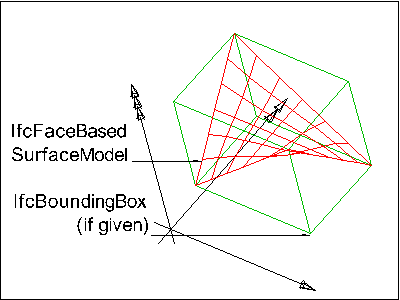 |
EXAMPLE As shown in Figure 1, the surface model representation is given
by an IfcShapeRepresentation, which includes a single item which is either an IfcShellBasedSurfaceModel, or an IfcFaceBasedSurfaceModel. In some cases it may also be useful to expose a simple
representation as a bounding box representation of the same complex
shape. |
|
Figure 1 — Element surface model
representation
|
|
|
| Body Tessellation Geometry | \IfcElement.Representation
\IfcProductDefinitionShape.Representations[*]
\IfcShapeRepresentation.ContextOfItems
\IfcGeometricRepresentationContext
| Any IfcElement (so far no further constraints are defined at the level of its subtypes) may be represented as a single or multiple tessellated surface models, in particular triangulated surface models.
|
| Body Brep Geometry | \IfcElement.Representation
\IfcProductDefinitionShape.Representations[*]
\IfcShapeRepresentation.ContextOfItems
\IfcGeometricRepresentationContext
| Any IfcElement (so far no further constraints are defined at the level of its subtypes) may be represented as a single or multiple Boundary Representation models (which are restricted to be faceted Brep's with or without voids). The Brep representation allows for the representation of complex element shape.
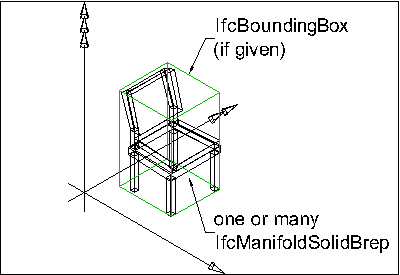 |
EXAMPLE As shown in Figure 1, the Brep representation is given by an
IfcShapeRepresentation, which includes one or more
items, all of type IfcFacetedBrep. In some cases it may be useful to also expose a simple
representation as a bounding box representation of the same complex
shape. |
|
Figure 1 — Building element body boundary
representation
|
|
|
| Body AdvancedBrep Geometry | \IfcElement.Representation
\IfcProductDefinitionShape.Representations[*]
\IfcShapeRepresentation.ContextOfItems
\IfcGeometricRepresentationContext
| An IfcElement (so far no further constraints are defined at the level of its subtypes or by view definitions) may be represented as a single or multiple boundary representation models, which include advanced surfaces, usually refered to as NURBS surfaces. The 'AdvancedBrep' representation allows for the representation of complex free-form element shape.
NOTE View definitions or implementer agreements may restrict or disallow the use of 'AdvancedBrep' geometry.
|
| Body CSG Geometry | \IfcElement.Representation
\IfcProductDefinitionShape.Representations[*]
\IfcShapeRepresentation.ContextOfItems
\IfcGeometricRepresentationContext
| Any IfcElement (so far no further constraints are defined at the level of its subtypes) may be represented a CSG primitive or CSG tree. The CSG representation allows for the representation of complex element shape.
NOTE View definitions or implementer agreements may restrict or disallow the use of 'CSG' geometry.
|
| Mapped Geometry | \IfcProduct.Representation
\IfcProductDefinitionShape.Representations[*]
\IfcShapeRepresentation.ContextOfItems
\IfcGeometricRepresentationContext
| Any IfcElement (so far no further constraints are defined at the level of its subtypes) may be represented using the 'MappedRepresentation'. This shall be supported as it allows for reusing the geometry definition of a type at all occurrences of the same type. The results are more compact data sets.
The same constraints, as given for 'SurfaceOrSolidModel', 'SurfaceModel', 'Tessellation', 'Brep', and 'AdvancedBrep' geometric representation, shall apply to the IfcRepresentationMap.
|
| Element Voiding | \IfcElement.HasOpenings[*]
\IfcRelVoidsElement.RelatedOpeningElement
\IfcOpeningElement.PredefinedType
\IfcOpeningElementTypeEnum
| Predefined generic type for an opening that is specified in an enumeration. There may be a property set given specificly for the predefined types.
{ .change-ifc2x4}
> IFC4 CHANGE The attribute has been added at the end of the entity definition. |
| Element Projecting | \IfcElement.HasProjections[*]
\IfcRelProjectsElement.RelatedFeatureElement
\IfcProjectionElement.PredefinedType
\IfcProjectionElementTypeEnum
| Predefined generic type for a projection element that is specified in an enumeration. There may be a property set given specificly for the predefined types.
{ .change-ifc2x4}
> IFC4 CHANGE The attribute has been added at the end of the entity definition. |
| Linear Placement | \IfcProduct.ObjectPlacement
\IfcLinearPlacement.PlacementRelTo
\IfcObjectPlacement
| Reference to object placement that provides the relative placement with its placement in a grid, local coordinate system or linear referenced placement. If it is omitted, then in the case of linear placement it is established by the origin of horizontal alignment of the referenced IfcAlignment Axis. In the case of local placement it is established by the geometric representation context. |
| Field | Mapping | Definition |
|---|
| (Query) | \IfcFacility
| |
|---|
| Spatial Composition | \IfcSpatialElement.Decomposes[*]
\IfcRelAggregates.RelatingObject
\IfcProject.Name
|
NOTE By using the inverse relationship IfcFacility.Decomposes it references IfcProject || IfcSite || IfcFacility through IfcRelAggregates.RelatingObject. If it refers to another instance of IfcFacility, the referenced IfcFacility needs to have a different and higher CompositionType, i.e. COMPLEX (if the other IfcBuilding has ELEMENT), or ELEMENT (if the other IfcFacility has PARTIAL).
|
| Spatial Decomposition | \IfcObjectDefinition.IsDecomposedBy[*]
\IfcRelAggregates.RelatedObjects[*]
\IfcSpatialElement.Name
\IfcLabel
|
NOTE By using the inverse relationship IfcFacility.IsDecomposedBy it references IfcFacility || IfcFacilityPart through IfcRelAggregates.RelatedObjects. If it refers to another instance of IfcFacility, the referenced IfcFacility needs to have a different and lower CompositionType, i.e. ELEMENT (if the other IfcFacility has COMPLEX), or PARTIAL (if the other IfcFacility has ELEMENT).
|
| Spatial Container | \IfcSpatialElement.ContainsElements[*]
\IfcRelContainedInSpatialStructure.RelatedElements[*]
\IfcProduct
|
NOTE If there are building elements and/or other elements directly related to the IfcFacility (like a curtain wall spanning several stories), they are associated with the IfcFacility by using the objectified relationship IfcRelContainedInSpatialStructure. The IfcFacility references them by its inverse relationship: > * IfcFacility.ContainsElements -- referencing any subtype of IfcProduct (with the exception of other spatial structure element) by IfcRelContainedInSpatialStructure.RelatedElements.
|
| Placement | \IfcProduct.ObjectPlacement
\IfcLocalPlacement.RelativePlacement
\IfcAxis2Placement3D
| The placement for IfcFacility is defined in its supertype IfcProduct. It is defined by either IfcLocalPlacement or by IfcLinearPlacement>/em> which define the local coordinate
system that is referenced by all geometric representations.
- The PlacementRelTo relationship of IfcObjectPlacement shall point (if relative placement is used) to the IfcSpatialStructureElement of type IfcSite, or of type IfcFacility (e.g. to position a facility relative to a facility complex, or a facility section to a facility).
- If the relative placement is not used, the absolute placement is defined within the world coordinate system.
|
| Body Geometry | \IfcElement.Representation
\IfcProductDefinitionShape.Representations['Body']
\IfcShapeRepresentation.ContextOfItems
\IfcGeometricRepresentationContext
| The body (or solid model) geometric representation (if the facility has an independent geometric representation) of IfcFacility is defined using faceted B-Rep capabilities (with or without voids), based on the IfcFacetedBrep or on the IfcFacetedBrepWithVoids. In the case of alignment based infrastructure, the geometric representation can be defined using IfcSectionedSolidHorizontal optionally IfcSweptAreaSolid.
NOTE Since the building shape is usually described by the exterior building elements, an independent shape representation shall only be given, if the building is exposed independently from its constituting elements and such independent geometric representation may be prohibited in model view definitions.
|
| Field | Mapping | Definition |
|---|
| (Query) | \IfcFacilityPart
| |
|---|
| Spatial Composition | \IfcSpatialElement.Decomposes[*]
\IfcRelAggregates.RelatingObject
\IfcProject.Name
|
NOTE By using the inverse relationship IfcFacilityPart.Decomposes it references (IfcFacility || IfcFacilityPart) through IfcRelAggregates.RelatingObject_IfcFacilityPart, the referenced
IfcFacilityPart needs to have a different and higher
CompositionType, i.e. COMPLEX (if the other IfcFacilityPart has ELEMENT), or ELEMENT (if the other
IfcFacilityPart has PARTIAL)._
|
| Spatial Container | \IfcSpatialElement.ContainsElements[*]
\IfcRelContainedInSpatialStructure.RelatedElements[*]
\IfcProduct
| If there are building elements and/or other elements directly related to the IfcFacilityPart (like most building elements, such as walls, columns, etc.), they are associated with the IfcFacilityPart by using the objectified relationship IfcRelContainedInSpatialStructure. The IfcFacilityPart references them by its inverse relationship:
- IfcFacilityPart.ContainsElements -- referencing any subtype of IfcProduct (with the exception of other spatial structure element) by IfcRelContainedInSpatialStructure.RelatedElements.
Elements can also be referenced in an IfcFacilityPart, for example, if they span through several storeys. This is expressed by using the objectified relationship IfcRelReferencedInSpatialStructure. Systems, such as building service or electrical distribution systems, zonal systems, or structural analysis systems, relate to IfcFacilityPart by using the objectified relationship IfcRelServicesBuildings.
|
| Placement | \IfcProduct.ObjectPlacement
\IfcLocalPlacement.RelativePlacement
\IfcAxis2Placement3D
| The local placement for IfcFacilityPart is defined in its supertype IfcProduct. It is defined by the IfcLocalPlacement, which defines the local coordinate system that is referenced by all geometric representations or by IfcLinearPlacement which measures along a linear positioning element.
- The PlacementRelTo attribute of IfcObjectPlacement shall point (if relative placement is used) to the IfcSpatialStructureElement of type IfcFacility, or of type IfcFacilityPart (e.g. to position a facility relative to a facility part complex, or a partial facility part to a facility part).
- If the relative placement is not used, the absolute placement is defined within the world coordinate system.
|
| Body Geometry | \IfcElement.Representation
\IfcProductDefinitionShape.Representations['Body']
\IfcShapeRepresentation.ContextOfItems
\IfcGeometricRepresentationContext
| The body (or solid model) geometric representation (if the facility part has an independent geometric representation) of IfcFacilityPart is defined using faceted B-Rep capabilities (with or without voids), based on the IfcFacetedBrep or on the IfcFacetedBrepWithVoids or in the case of alignment based infrastructure using IfcSectionedSolidHorizontal optionally IfcSweptAreaSolid.
NOTE Since the facility part shape is usually described by the exterior facility elements, an independent shape representation shall only be given, if the facility part is exposed independently from its constituting elements and such independent geometric representation may be prohibited in model view definitions.
|
| Field | Mapping | Definition |
|---|
| (Query) | \IfcMemberStandardCase
| |
|---|
| Object Typing | \IfcObject.IsTypedBy[*]
\IfcRelDefinesByType.RelatingType
\IfcTypeObject.Name
| The IfcMemberStandardCase defines in addition that the IfcMemberType should have a unique IfcMaterialProfileSet, that is referenced by the IfcMaterialProfileSetUsage assigned to all occurrences of this IfcMemberType.
|
| Material Profile Set Usage | \IfcProduct.HasAssociations[*]
\IfcRelAssociatesMaterial.RelatingMaterial
\IfcMaterialProfileSetUsage.ForProfileSet
\IfcMaterialProfileSet.MaterialProfiles[*]
\IfcMaterialProfile.Name
| Figure 1 illustrates assignment of IfcMaterialProfileSetUsage and IfcMaterialProfileSet to the IfcMemberStandardCase as the member occurrence and to the IfcMemberType. The same IfcMaterialProfileSet shall be shared by many occurrences of IfcMaterialProfileSetUsage. This relationship shall be consistent to the relationship between the IfcMemberType and the IfcMemberStandardCase.
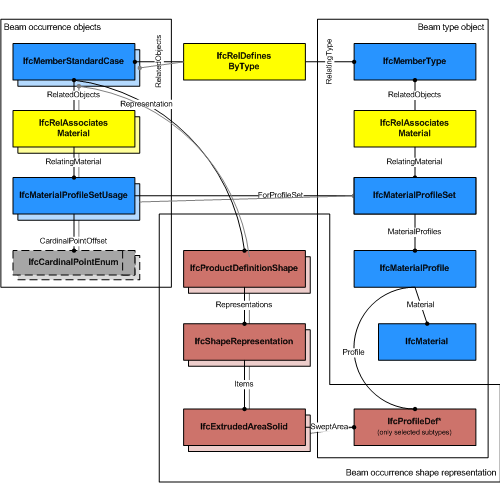 | Figure 1 — Member profile usage |
Figure 2 illustrates assignment of a composite profile by using IfcCompositeProfile for geometric representation and several IfcMaterialProfile's within the IfcMaterialProfileSet. The number of IfcMaterialProfile's within the IfcMaterialProfileSet is restricted to maximal 2 and requires the use of IfcExtrudedAreaSolidTapered, or IfcRevolvedAreaSolidTapered for the correct 'Body' shape representation.
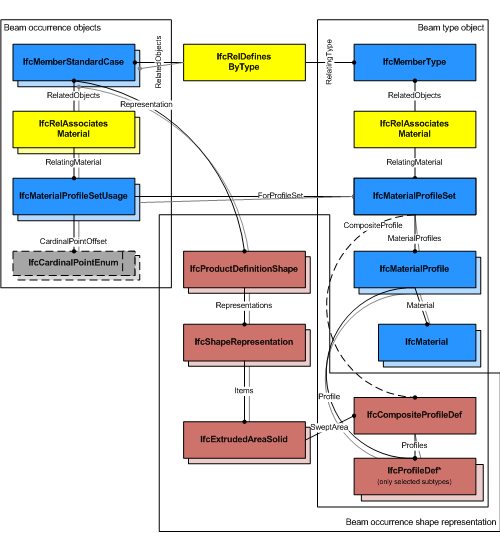 | Figure 2 — Member composite profiles |
The material of the IfcMemberStandardCase is defined by IfcMaterialProfileSetUsage and attached by the IfcRelAssociatesMaterial.RelatingMaterial. It is accessible by the inverse HasAssociations relationship. Composite profile members can be represented by refering to several IfcMaterialProfile's within the IfcMaterialProfileSet that is referenced from the IfcMaterialProfileSetUsage.
Material information can also be given at the IfcMemberType, defining the common attribute data for all occurrences of the same type. It is then accessible by the inverse IsDefinedBy relationship pointing to IfcMemberType.HasAssociations and via IfcRelAssociatesMaterial.RelatingMaterial. See Type Use
Definition for additional agreements for standard members.
|
| Product Placement | \IfcProduct.ObjectPlacement
\IfcLocalPlacement.RelativePlacement
\IfcAxis2Placement3D
| The following restriction is imposed:
- The local placement shall provide the location and directions for the standard member, the x/y plane is the plane for the start profile, and the z-axis is the extrusion axis for the member body (in case of rotation, the tangent direction).
|
| Axis 3D Geometry | \IfcElement.Representation
\IfcProductDefinitionShape.Representations['Axis']
\IfcShapeRepresentation.ContextOfItems
\IfcGeometricRepresentationContext
| The following additional constraints apply to the 'Axis' representation, if the 'Body' shape representation has the RepresentationType : 'SweptSolid':
 |
EXAMPLE As shown in Figure 101, the axis representation can be used to represent the system length of a member that may extent the body length of the member.
|
Figure 1 — Member axis representation |
|
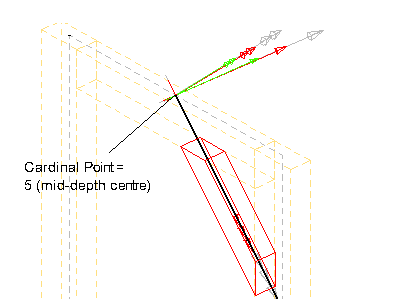 |
EXAMPLE As shown in Figure 102, the axis representation shall be used to represent the cardinal point as the offset between the 'Axis' and the extrusion path of the member. The extrusion path is provided as IfcExtrudedAreaSolid.ExtrudedDirection and should be parallel to the 'Axis'. It has to be guaranteed that the value provided by IfcMaterialProfileSetUsage.CardinalPoint is consistent to the IfcExtrudedAreaSolid.Position.
|
Figure 2 — Member axis cardinal point |
|
|
| Body SweptSolid Geometry | \IfcElement.Representation
\IfcProductDefinitionShape.Representations[*]
\IfcShapeRepresentation.ContextOfItems
\IfcGeometricRepresentationContext
| The following additional constraints apply to the 'SweptSolid' representation:
- Solid: IfcExtrudedAreaSolid, IfcRevolvedAreaSolid shall be supported
- Profile: all subtypes of IfcProfileDef (with exception of IfcArbitraryOpenProfileDef)
- Profile Position : For all single profiles, the IfcParameterizedProfileDef.Position shall be NIL, or having Location = 0.,0. and RefDirection = 1.,0.
- Extrusion: perpendicular to the profile direction.
- Orientation: The y-axis of the profile, as determined by IfcSweptAreaSolid.Position.P[2] shall point to the Z-Axis. It indicates the "role" of the column, a role=0° means y-axis of profile = Z-axis of reference coordinate system. In the exception of a vertical member, the y-axis shall point to the Y-axis.
Figure 1 illustrates a 'SweptSolid' geometric representation with cardinal point applied as 1 (bottom left).
The following interpretation of dimension parameter applies for rectangular members:
- IfcRectangleProfileDef.YDim interpreted as member width
- IfcRectangleProfileDef.XDim interpreted as member depth
The following interpretation of dimension parameter applies for circular members:
- IfcCircleProfileDef.Radius interpreted as beam radius.
 | Figure 1 — Member body extrusion |
|
| Body AdvancedSweptSolid Geometry | \IfcElement.Representation
\IfcProductDefinitionShape.Representations[*]
\IfcShapeRepresentation.ContextOfItems
\IfcGeometricRepresentationContext
| The following additional constraints apply to the 'AdvancedSweptSolid' representation type:
NOTE View definitions and implementer agreement can further constrain the allowed swept solid types.
NOTE Using IfcExtrudedAreaSolidTapered, or IfcRevolvedAreaSolidTapered requires the use of two IfcMaterialProfile's within the IfcMaterialProfileSet assinged to the IfcBeamStandardCase
- Profile: see 'SweptSolid' geometric representation
- Profile Position : see 'SweptSolid' geometric representation
- Extrusion: not applicable
|
| Body Clipping Geometry | \IfcElement.Representation
\IfcProductDefinitionShape.Representations[*]
\IfcShapeRepresentation.ContextOfItems
\IfcGeometricRepresentationContext
| The following constraints apply to the advanced representation:
- Solid: see 'SweptSolid' geometric representation
- Profile: see 'SweptSolid' geometric representation
- Profile Position : see 'SweptSolid' geometric representation
- Extrusion: see 'SweptSolid' geometric representation
- Boolean result: The IfcBooleanClippingResult shall be supported, allowing for Boolean differences between the swept solid (here IfcExtrudedAreaSolid) and one or several IfcHalfSpaceSolid (or its subtypes).
Figure 1 illustrates an advanced geometric representation with use of IfcBooleanClippingResult between an IfcExtrudedAreaSolid and an IfcHalfSpaceSolid to create a clipped body, with cardinal point applied as 4 (mid-depth left).
 | Figure 1 — Member body clipping |
|
| Field | Mapping | Definition |
|---|
| (Query) | \IfcObject
| |
|---|
| Object User Identity | \IfcObject.Name
\IfcLabel
| An attribute Name and optionally Description can be used for all subypes of IfcObject. For those subtypes, that have an object type definition, such as ifcBeam - IfcBeamType, the common Name and optionally Description is associated with the object type.
|
| Object Predefined Type | \IfcObject.ObjectType
\IfcLabel
| The type denotes a particular type that indicates the object further. The use has to be established at the level of instantiable subtypes. In particular it holds the user defined type, if the enumeration of the attribute _PredefinedType_ is set to USERDEFINED. |
| Object Typing | \IfcObject.IsTypedBy[*]
\IfcRelDefinesByType.RelatingType
\IfcTypeObject.Name
| Any object occurrence can be typed by being assigned to a common object type utilizing this concept. A particular rule, restricting the applicable subtypes of IfcTypeObject that can be assigned, is introduced by overriding this concept at the level of subtypes of IfcObject.
|
| Property Sets for Objects | \IfcObject
| Any object occurrence can hold property sets, each being a set of individual properties having name, description, value(s) and unit(s). A reference to applicable property sets, being part of this specification, is introduced at the level of sub types of IfcObject.
|
| Property Sets with Override | \IfcObject
| Any object occurrence can hold property sets, either directly at the object occurrence as element specific property sets, or at the object type, as type property sets. In this case, the properties that are provided to the object occurrence are the combinations of element specific and type properties. In case, that the same property (within the same property set, is defined both, in occurrence and type properties, the property value of the occurrence property overrides the property value of the type property.
|
| Field | Mapping | Definition |
|---|
| (Query) | \IfcOpeningElement
| |
|---|
| \IfcObject
| The IFC class identifier indicating the subtype of object. |
| \IfcObject.IsDefinedBy[*]
\IfcRelDefinesByProperties.RelatingPropertyDefinition
\IfcElementQuantity.Name
\IfcLabel
| Optional name for use by the participating software systems or users. For some subtypes of IfcRoot the insertion of the Name attribute may be required. This would be enforced by a where rule. |
| Product Local Placement | \IfcProduct.ObjectPlacement
\IfcLocalPlacement.RelativePlacement
\IfcAxis2Placement3D
| The local placement for IfcOpeningElement is defined in its supertype IfcProduct. It is defined by the IfcLocalPlacement, which defines the local coordinate system that is referenced by all geometric representations.
- The PlacementRelTo relationship of IfcLocalPlacement should point to the local placement of the same element, which is voided by the opening, i.e. referred to by VoidsElement.RelatingBuildingElement.
|
| Body Geometry | \IfcElement.Representation
\IfcProductDefinitionShape.Representations['Body']
\IfcShapeRepresentation.ContextOfItems
\IfcGeometricRepresentationContext
| The 'Body' representation of IfcOpeningElement can be represented using the representation types 'SweptSolid', and 'Brep'. The representation type 'Brep' is explained at IfcFeatureElement
Swept Solid Representation Type with Horizontal
Extrusion
The 'SweptSolid' geometric representation of IfcOpeningElement, using horizontal extrusion direction (for walls), is defined using the swept area solid geometry. The following attribute values for the IfcShapeRepresentation holding this geometric representation shall be used:
- RepresentationIdentifier : 'Body'
- RepresentationType : 'SweptSolid'
The following additional constraints apply to the swept solid representation:
NOTE In case of non-parallel jambs, the shape representation shall be a 'SweptSolid' representation with vertical extrusion.
Figure 1 illustrates an opening with horizontal extrusion.
NOTE The local placement directions for the IfcOpeningElement are only given as an example, other directions are valid as well.
 | Figure 1 — Opening with full extrusion |
Figure 2 illustrates an opening for a recess.
NOTE The local placement directions for the IfcOpeningElement are only given as an example, other directions are valid as well.
NOTE Rectangles are now defined centric, the placement location has to be set:
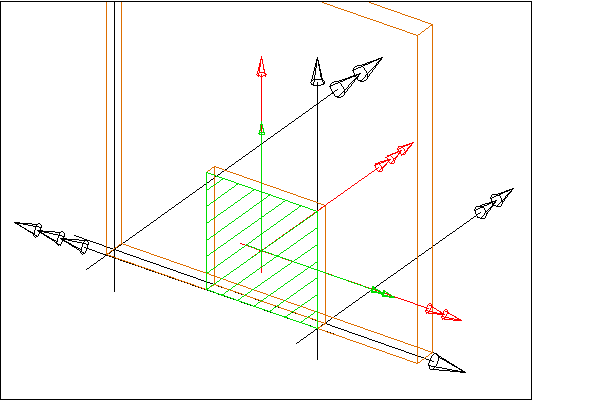 | Figure 2 — Opening with recess extrusion |
Swept Solid Representation with Vertical Extrusion
The 'SweptSolid' geometric representation of IfcOpeningElement, using vertical extrusion direction (for walls), is defined using the swept area solid geometry, however the extrusion direction may be vertical, i.e. in case of a wall opening, the extrusion would be in the direction of the wall height. The following attribute values for the IfcShapeRepresentation holding this geometric representation shall be used:
- RepresentationIdentifier : 'Body'
- RepresentationType : 'SweptSolid'
The following additional constraints apply to the swept solid representation:
Vertical extrusions shall be used when an opening or recess has a non rectangular foot print geometry that does not change along the height of the opening or recess.
Figure 3 shows a vertical extrusion with multiple extrusion bodies for the opening. Each extrusion body has a different extrusion lenght.
NOTE The local placement directions for the IfcOpeningElement are only given as an example, other directions are valid as well.
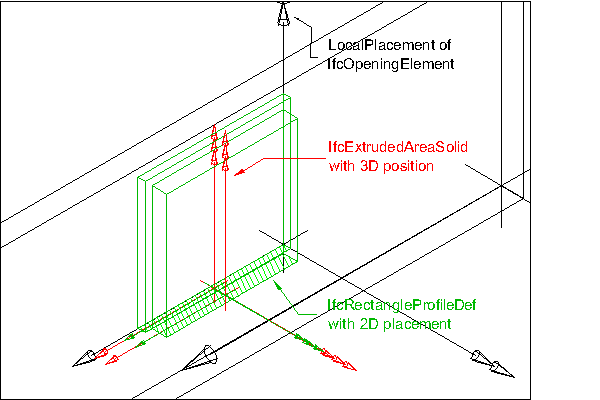 | Figure 3 — Opening with multiple extrusions |
|
| Reference Geometry | \IfcProduct.Representation
\IfcProductDefinitionShape.Name
| Since there are no Boolean operations, either as IfcBooleanResult or implicitly by IfcRelVoidsElement the geometry of the IfcOpeningElement shall not be used to subtract the opening from the 'Body' shape representation of the voided element.
|
| Field | Mapping | Definition |
|---|
| (Query) | \IfcPermit
| |
|---|
| Approval | \IfcObjectDefinition.HasAssociations[*]
\IfcRelAssociatesApproval.RelatingApproval
\IfcApproval.Name
\IfcLabel
| Approvals may be associated to indicate the status of acceptance or rejection using the IfcRelAssociatesApproval relationship where RelatingApproval refers to an IfcApproval and RelatedObjects contains the IfcPermit. Approvals may be split into sub-approvals using IfcApprovalRelationship to track approval status separately for each party where RelatingApproval refers to the higher-level approval and RelatedApprovals contains one or more lower-level approvals. The hierarchy of approvals implies sequencing such that a higher-level approval is not executed until all of its lower-level approvals have been accepted.
|
| \IfcObject
| The IFC class identifier indicating the subtype of object. |
| Aggregation | | |
| Nesting | \IfcObjectDefinition.IsNestedBy[*]
\IfcRelNests.RelatedObjects[*]
\IfcObject
| The object definitions, either non-product object occurrences or non-product object types, that are being nestes. They are defined as the parts in the ordered whole/part relationship - i.e. there is an implied order among the parts expressed by the position within the list of _RelatedObjects_.
{ .change-ifc2x4}
> IFC4 CHANGE The attribute has been demoted from the supertype _IfcRelDecomposes_ and defines the ordered set of parts within the nest. |
| Control Assignment | \IfcControl.Controls[*]
\IfcRelAssignsToControl.RelatedObjects[*]
\IfcObject
| Figure 1 illustrates assignment relationships as indicated:
The IfcPermit may have assignments of its own using the IfcRelAssignsToControl relationship where RelatingControl refers to the IfcPermit and RelatedObjects contains one or more objects of the following types:
- IfcActor: Organization(s) bound to the permit, typically a single contractor.
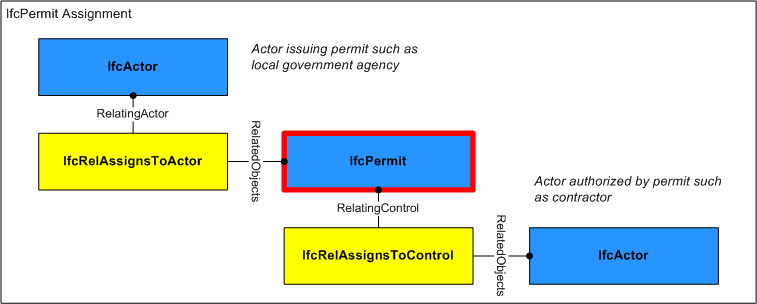 | Figure 1 — Permit assignment |
|
| Field | Mapping | Definition |
|---|
| (Query) | \IfcPlate
| |
|---|
| Object Typing | \IfcObject.IsTypedBy[*]
\IfcRelDefinesByType.RelatingType
\IfcTypeObject.Name
| Optional name for use by the participating software systems or users. For some subtypes of IfcRoot the insertion of the Name attribute may be required. This would be enforced by a where rule. |
| \IfcObject
| The IFC class identifier indicating the subtype of object. |
| \IfcObject.IsDefinedBy[*]
\IfcRelDefinesByProperties.RelatingPropertyDefinition
\IfcElementQuantity.Name
\IfcLabel
| Optional name for use by the participating software systems or users. For some subtypes of IfcRoot the insertion of the Name attribute may be required. This would be enforced by a where rule. |
| Material Layer Set | \IfcObjectDefinition.HasAssociations[*]
\IfcRelAssociatesMaterial.RelatingMaterial
\IfcMaterialLayerSet.MaterialLayers[*]
\IfcMaterialLayer.Name
\IfcLabel
| The material of the IfcPlate is defined by IfcMaterialLayerSet, or by IfcMaterial, and it is attached either directly or at the IfcPlateType.
NOTE It is illegal to assign an IfcMaterialLayerSetUsage to an IfcPlate. Only the subtype IfcPlateStandardCase supports this concept.
|
| Spatial Containment | \IfcElement.ContainedInStructure[*]
\IfcRelContainedInSpatialStructure.RelatingStructure
\IfcSpatialElement.Name
\IfcLabel
| The IfcPlate, as any subtype of IfcBuildingElement, may participate alternatively in one of the two different containment relationships:
- the Spatial Containment (defined here), or
- the Element Composition.
|
| Surface 3D Geometry | \IfcElement.Representation
\IfcProductDefinitionShape.Representations[*]
\IfcShapeRepresentation.ContextOfItems
\IfcGeometricRepresentationContext
|
NOTE The 'Surface' can be used to define a surfacic model of the building (e.g. for analytical purposes, or for reduced Level of Detail representation).
|
| Body SweptSolid Geometry | \IfcElement.Representation
\IfcProductDefinitionShape.Representations[*]
\IfcShapeRepresentation.ContextOfItems
\IfcGeometricRepresentationContext
| The following additional constraints apply to the 'SweptSolid' representation:
- Solid: IfcExtrudedAreaSolid is required,
- Profile: IfcArbitraryClosedProfileDef, IfcArbitraryProfileDefWithVoids, IfcRectangleProfileDef, IfcCircleProfileDef, IfcEllipseProfileDef shall be supported.
- Extrusion: The profile can be extruded perpendicularly or non-perpendicularly to the plane of the swept profile.
|
| Body Clipping Geometry | \IfcElement.Representation
\IfcProductDefinitionShape.Representations[*]
\IfcShapeRepresentation.ContextOfItems
\IfcGeometricRepresentationContext
| Definition of the representation context for which the different subtypes of representation are valid. |
| Product Assignment | \IfcProduct.ReferencedBy[*]
\IfcRelAssignsToProduct.RelatedObjects[*]
\IfcObject
| Related objects, which are assigned to a single object. The type of the single (or relating) object is defined in the subtypes of IfcRelAssigns. |
| Field | Mapping | Definition |
|---|
| (Query) | \IfcPlateStandardCase
| |
|---|
| Material Layer Set Usage | \IfcProduct.HasAssociations[*]
\IfcRelAssociatesMaterial.RelatingMaterial
\IfcMaterialLayerSetUsage.ForLayerSet
\IfcMaterialLayerSet.MaterialLayers[*]
\IfcMaterialLayer.Name
| The material of the IfcPlateStandardCase is defined by IfcMaterialLayerSetUsage and attached by the IfcRelAssociatesMaterial.RelatingMaterial. It is accessible by the inverse HasAssociations relationship. Multi-layer plates can be represented by refering to several IfcMaterialLayer's within the IfcMaterialLayerSet that is referenced from the IfcMaterialLayerSetUsage.
Material information can also be given at the IfcPlateType, defining the common attribute data for all occurrences of the same type. It is then accessible by the inverse IsDefinedBy relationship pointing to IfcPlateType.HasAssociations and via IfcRelAssociatesMaterial.RelatingMaterial.
The IfcPlateStandardCase defines in addition that the IfcPlateType should have a unique IfcMaterialLayerSet, that is referenced by the IfcMaterialLayerSetUsage assigned to all occurrences of this IfcPlateType.
Figure 1 illustrates assignment of IfcMaterialLayerSetUsage and IfcMaterialLayerSet to the IfcPlateStandardCase as the plate occurrence and to the IfcPlateType. The same IfcMaterialLayerSet shall be shared by many occurrences of IfcMaterialLayerSetUsage. This relationship shall be consistent to the relationship between the IfcPlateType and the IfcPlateStandardCase.
|
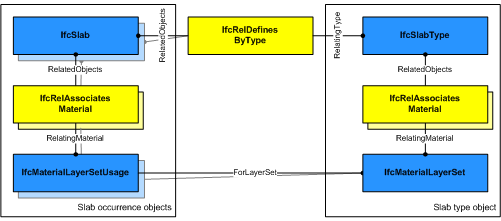
|
Figure 1 — Plate type definition |
As shown in Figure 106, the following conventions shall be met:
- The reference coordinate system is the coordinate system established by the IfcExtrudedAreaSolid.Position.
- The reference plane is the plane defined by the extruded profile of IfcExtrudedAreaSolid.SweptSolid. The IfcMaterialLayerSetUsage.OffsetFromReferenceLine is given as a distance from this plane.
- The IfcMaterialLayerSetUsage.DirectionSense defines how the IfcMaterialLayer's are assigned to the reference plane. POSITIVE means in direction to the positive z-axis of the reference coordinate system.
- The IfcMaterialLayerSetUsage.OffsetFromReferenceLine is the distance parallel to the reference plane and always perpendicular to the base (XY) plane of the reference coordinate system. This is independent of a potential non-perpendicular extrusion given by IfcExtrudedAreaSolid.ExtrudedDirection <> 0.,0.,1. A positive value of IfcMaterialLayerSetUsage.OffsetFromReferenceLine would then point into the positive z-axis of the reference coordinate system.
- The Thickness of each IfcMaterialLayer shall be the parallel distance (measured perpendicular to the base plane). The TotalThickness of the IfcMaterialLayerSet is the sum of all layer thicknesses and in case of a perpendicular extrusion identical with IfcExtrudedAreaSolid.Depth
- The IfcMaterialLayerSetUsage.LayerSetDirection i always AXIS3.
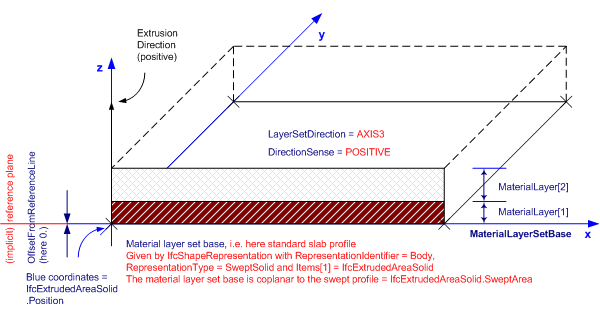 | Figure 2 — Plate material layers |
|
| Product Placement | \IfcProduct.ObjectPlacement
\IfcLocalPlacement.RelativePlacement
\IfcAxis2Placement3D
| The following restriction is imposed:
- The local placement shall provide the location and directions for the standard plate, the x/y plane is the plane for the profile, and the z-axis is the extrusion axis for the plate body.
|
| Body SweptSolid Geometry | \IfcElement.Representation
\IfcProductDefinitionShape.Representations[*]
\IfcShapeRepresentation.ContextOfItems
\IfcGeometricRepresentationContext
| The following additional constraints apply to the swept solid representation:
- Solid: IfcExtrudedAreaSolid is required,
- Profile: IfcArbitraryClosedProfileDef, IfcRectangleProfileDef, IfcRoundedRectangleProfileDef, IfcCircleProfileDef, IfcEllipseProfileDef shall be supported.
- Extrusion: The profile can be extruded perpendicularly or non-perpendicularly to the plane of the swept profile.
- Material: The definition of the IfcMaterialLayerSetUsage, particularly of the OffsetFromReferenceLine and the ForLayerSet.TotalThickness, has to be consistent to the 'SweptSolid' representation.
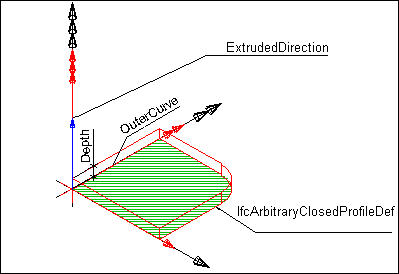 |
EXAMPLE Figure 1 illustrates a 'SweptSolid' geometric representation. The following interpretation of dimension parameter applies for polygonal plates (in ground floor view): IfcArbitraryClosedProfileDef.OuterCurve being a closed bounded curve is interpreted as area (or foot print) of the plate.
|
Figure 1 — Plate body extrusion |
|
|
| Body Clipping Geometry | \IfcElement.Representation
\IfcProductDefinitionShape.Representations[*]
\IfcShapeRepresentation.ContextOfItems
\IfcGeometricRepresentationContext
| The following constraints apply to the 'Clipping' representation:
- Solid: see 'SweptSolid' shape representation,
- Profile: see 'SweptSolid' shape representation,
- Extrusion: see 'SweptSolid' shape representation,
- Material: see 'SweptSolid' shape representation,
- Boolean result: The IfcBooleanClippingResult shall be supported, allowing for Boolean differences between the swept solid (here IfcExtrudedAreaSolid) and one or several IfcHalfSpaceSolid.
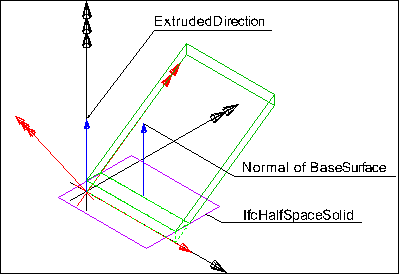 |
EXAMPLE Figure 1 illustrates a 'Clipping' geometric representation with definition of a plate using advanced geometric representation. The profile is extruded non-perpendicular and the plate body is clipped at the eave.
|
Figure 1 — Plate body clipping |
|
|
| Field | Mapping | Definition |
|---|
| (Query) | \IfcPositioningElement
| |
|---|
| Placement | \IfcProduct.ObjectPlacement
\IfcLocalPlacement.RelativePlacement
\IfcAxis2Placement3D
| The local placement for IfcGrid is defined in its supertype IfcProduct. It is defined by the IfcLocalPlacement, which defines the local coordinate system that is referenced by all geometric representations.
- The PlacementRelTo relationship of IfcLocalPlacement shall point (if given) to the local placement of the same IfcSpatialStructureElement, which is used in the ContainedInStructure inverse attribute, or to a spatial structure element at a higher level, referenced by that.
- If the relative placement is not used, the absolute placement is defined within the world coordinate system.
|
| Footprint Geometry | \IfcProduct.Representation
\IfcProductDefinitionShape.Representations[*]
\IfcShapeRepresentation.RepresentationIdentifier
\IfcLabel
| The 2D geometric representation of IfcGrid is defined using the 'GeometricCurveSet' geometry. The following attribute values should be inserted
- IfcShapeRepresentation.RepresentationIdentifier = 'FootPrint'.
- IfcShapeRepresentation.RepresentationType = 'GeometricCurveSet' .
The following constraints apply to the 2D representation:
|
| Field | Mapping | Definition |
|---|
| (Query) | \IfcProject
| |
|---|
| Project Units | \IfcContext.UnitsInContext
\IfcUnitAssignment.Units[*]
\IfcDerivedUnit.UnitType
\IfcDerivedUnitEnum
| Name of the derived unit chosen from an enumeration of derived unit types for use in IFC models. |
| Project Representation Context | \IfcContext.RepresentationContexts[*]
\IfcGeometricRepresentationContext.ContextIdentifier
\IfcLabel
| The optional identifier of the representation context as used within a project. |
| Project Global Positioning | \IfcContext.RepresentationContexts[*]
\IfcGeometricRepresentationContext.HasCoordinateOperation[*]
\IfcMapConversion.Eastings
\IfcLengthMeasure
| The representation context of the project refers to a global positioning, i.e. the local engineering coordinate system of the project has a mapping to a defined projected coordinate system (a rectangular map coordinate system, as used in GIS systems)
|
| Project Classification Information | \IfcContext.HasAssociations[*]
\IfcRelAssociatesClassification.RelatingClassification
\IfcClassification.Source
\IfcLabel
| Source (or publisher) for this classification.
> NOTE that the source of the classification means the person or organization that was the original author or the person or organization currently acting as the publisher. |
| Project Document Information | \IfcContext.HasAssociations[*]
\IfcRelAssociatesDocument.RelatingDocument
\IfcDocumentInformation.Location
\IfcURIReference
| Resource identifier or locator, provided as URI, URN or URL, of the document information for online references.
{ .change-ifc2x4}
> IFC4 CHANGE New attribute added at the place of the removed attribute _DocumentReferences_. |
| Project Library Information | \IfcContext.HasAssociations[*]
\IfcRelAssociatesLibrary.RelatingLibrary
\IfcLibraryInformation.Version
\IfcLabel
| Identifier for the library version used for reference. |
| Project Declaration | \IfcContext.Declares[*]
\IfcRelDeclares.RelatedDefinitions[*]
| The IfcProject is also the context for other information about the construction project such as a work plan. Non-product structures are assigned by their first level object to IfcProject using the IfcRelDeclares relationship. The IfcProject provides the context for work plans (or other non-product based) descriptions of the construction project. It is handled by the objectified relationship IfcRelDeclares.
NOTE The spatial structure and the schedule structure can be decomposed. For example the IfcBuilding can be decomposed into IfcBuildingStorey's, and the IfcWorkPlan can be decomposed into IfcWorkSchedule's.
NOTE The products and tasks can be decomposed further. For example the IfcCurtainWall can be decomposed into IfcMember and IfcPlate, the IfcTask can be decomposed into other IfcTask's.
NOTE The products and tasks can have direct linking relationships. For example the IfcCurtainWall can be assigned to a IfcTask as an input or output for a construction schedule.
Figure 1 illustrates the use of IfcProject as context for work plans or work schedules.
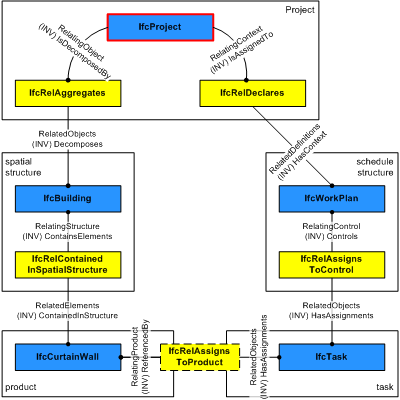 | Figure 1 — Project spatial and work plan structure |
|
| Spatial Decomposition | \IfcObjectDefinition.IsDecomposedBy[*]
\IfcRelAggregates.RelatedObjects[*]
\IfcSpatialElement.Name
\IfcLabel
| The IfcProject is used to reference the root of the spatial structure of a building or other construction project (that serves as the primary project breakdown and is required to be hierarchical). The spatial structure elements are linked together, and to the IfcProject, by using the objectified relationship IfcRelAggregates.
The following constraints are applied to using the relationshio IfcRelAggregates in context of IfcProject
NOTE The anomaly to use the composition structure through IfcRelAggregates for assigning the uppermost spatial container to IfcProject is due to upward compatibility reasons with earlier releases of this standard.
Figure 1 illustrates project relationships with spatial structures, elements, and element type libraries.
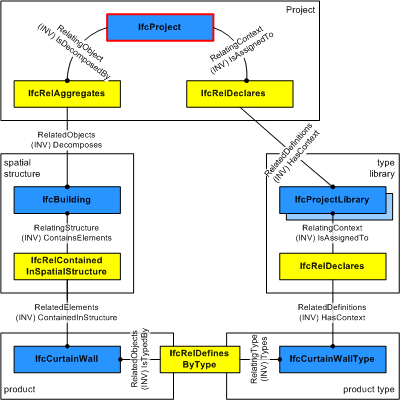 | Figure 1 — Project spatial structure, products and product type library |
|
| Field | Mapping | Definition |
|---|
| (Query) | \IfcProjectionElement
| |
|---|
| Property Sets | \IfcObject
| The IFC class identifier indicating the subtype of object. |
| \IfcObject.IsDefinedBy[*]
\IfcRelDefinesByProperties.RelatingPropertyDefinition
\IfcElementQuantity.Name
\IfcLabel
| Optional name for use by the participating software systems or users. For some subtypes of IfcRoot the insertion of the Name attribute may be required. This would be enforced by a where rule. |
| Placement | \IfcProduct.ObjectPlacement
\IfcLocalPlacement.RelativePlacement
\IfcAxis2Placement3D
| The local placement for IfcOpeningRecess is defined in its supertype IfcProduct. It is defined by the IfcLocalPlacement, which defines the local coordinate system that is referenced by all geometric representations.
- The PlacementRelTo relationship of IfcLocalPlacement should point to the local placement of the same element, to which the projection adds, i.e. referred to by ProjectsElement.RelatingBuildingElement.
|
| Body Geometry | \IfcElement.Representation
\IfcProductDefinitionShape.Representations['Body']
\IfcShapeRepresentation.ContextOfItems
\IfcGeometricRepresentationContext
| The geometric representation of IfcProjectionElement is defined using the swept area solid geometry. The following attribute values for the IfcShapeRepresentation holding this geometric representation shall be used:
- RepresentationIdentifier : 'Body'
- RepresentationType : 'SweptSolid'
The following additional constraints apply to the swept solid representation:
As shown in Figure 1, the following interpretation of dimension parameter applies for rectangular projection:
- IfcRectangleProfileDef.YDim interpreted as projection width
- IfcRectangleProfileDef.XDim interpreted as projection height
- IfcExtrudedAreaSolid.Depth is interpreted as projection depth
NOTE Rectangles are now defined centric, the placement location has to be set: > * IfcCartesianPoint(XDim/2,YDim/2)
NOTE The local placement directions for the IfcProjectionElement are only given as an example, other directions are valid as well.
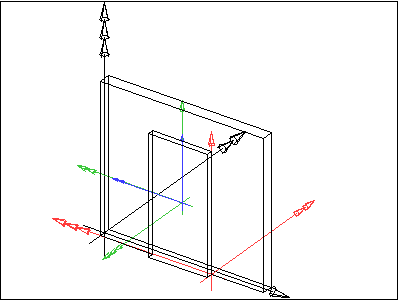 | Figure 1 — Projection representation |
The general b-rep geometric representation of IfcProjectionElement is defined using the Brep geometry. The Brep representation allows for the representation of complex element shape. The following attribute values for the IfcShapeRepresentation holding this geometric representation shall be used:
- RepresentationIdentifier : 'Body'
- RepresentationType : 'Brep'
|
| Field | Mapping | Definition |
|---|
| (Query) | \IfcProjectOrder
| |
|---|
| Approval | \IfcObjectDefinition.HasAssociations[*]
\IfcRelAssociatesApproval.RelatingApproval
\IfcApproval.Name
\IfcLabel
| Approvals may be associated to indicate the status of acceptance or rejection using the IfcRelAssociatesApproval relationship where RelatingApproval refers to an IfcApproval and RelatedObjects contains the IfcProjectOrder. Approvals may be split into sub-approvals using IfcApprovalRelationship to track approval status separately for each party where RelatingApproval refers to the higher-level approval and RelatedApprovals contains one or more lower-level approvals. The hierarchy of approvals implies sequencing such that a higher-level approval is not executed until all of its lower-level approvals have been accepted.
|
| \IfcObject
| The IFC class identifier indicating the subtype of object. |
| Aggregation | | As shown in Figure 160, an IfcProjectOrder may be aggregated into components.
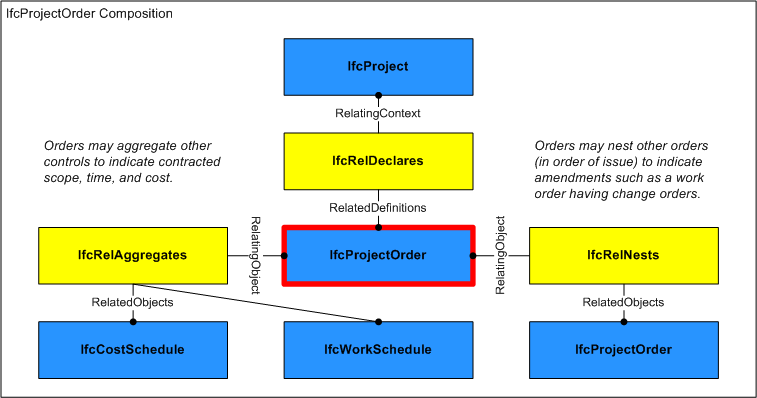 | Figure 1 — Project order composition |
|
| Nesting | \IfcObjectDefinition.IsNestedBy[*]
\IfcRelNests.RelatedObjects[*]
\IfcObject
| The object definitions, either non-product object occurrences or non-product object types, that are being nestes. They are defined as the parts in the ordered whole/part relationship - i.e. there is an implied order among the parts expressed by the position within the list of _RelatedObjects_.
{ .change-ifc2x4}
> IFC4 CHANGE The attribute has been demoted from the supertype _IfcRelDecomposes_ and defines the ordered set of parts within the nest. |
| Control Assignment | \IfcControl.Controls[*]
\IfcRelAssignsToControl.RelatedObjects[*]
\IfcObject
| Figure 1 illustrates IfcProjectOrder assignment relationships as indicated:
The IfcProjectOrder may have assignments of its own using the IfcRelAssignsToControl relationship where RelatingControl refers to the IfcProjectOrder and RelatedObjects contains one or more objects of the following types:
- IfcActor: Organization(s) contracted to fulfill the order, typically a single contractor, subcontractor, or supplier.
 | Figure 1 — Project order assignment |
|
| Field | Mapping | Definition |
|---|
| (Query) | \IfcRoof
| |
|---|
| Object Typing | \IfcObject.IsTypedBy[*]
\IfcRelDefinesByType.RelatingType
\IfcTypeObject.Name
| Optional name for use by the participating software systems or users. For some subtypes of IfcRoot the insertion of the Name attribute may be required. This would be enforced by a where rule. |
| \IfcObject
| The IFC class identifier indicating the subtype of object. |
| \IfcObject.IsDefinedBy[*]
\IfcRelDefinesByProperties.RelatingPropertyDefinition
\IfcElementQuantity.Name
\IfcLabel
| Optional name for use by the participating software systems or users. For some subtypes of IfcRoot the insertion of the Name attribute may be required. This would be enforced by a where rule. |
| Spatial Containment | \IfcElement.ContainedInStructure[*]
\IfcRelContainedInSpatialStructure.RelatingStructure
\IfcSpatialElement.Name
\IfcLabel
| Optional name for use by the participating software systems or users. For some subtypes of IfcRoot the insertion of the Name attribute may be required. This would be enforced by a where rule. |
| Element Decomposition | \IfcElement.IsDecomposedBy[*]
\IfcRelAggregates.RelatedObjects[*]
\IfcElement.Name
\IfcLabel
| Geometric representation by aggregated elements
If the IfcRoof has components (referenced by SELF\IfcObject.IsDecomposedBy) then no independent geometric representation shall defined for the IfcRoof. The IfcRoof is then geometrically represented by the geometric representation of its components. The components are accessed via SELF\IfcObject.IsDecomposedBy[1].RelatedObjects. The geometric representations that are supported for the aggregated elements are defined with each element. See geometric use definition for IfcSlab, IfcBeam, IfcColumn, IfcBuildingElementPart and other subtypes of IfcBuildingElement.
Figure 1 illustrates roof placement, with an IfcRoof defining the local placement for all aggregated elements.
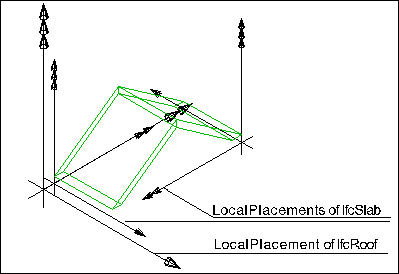 | Figure 1 — Roof placement |
|
| Placement | \IfcProduct.ObjectPlacement
\IfcLocalPlacement.RelativePlacement
\IfcAxis2Placement3D
| The following restriction may be imposed by view definitions or implementer agreements:
- If the IfcRoof establishes an aggregate, then all contained elements shall be placed relative to the IfcRoof.ObjectPlacement.
|
| Field | Mapping | Definition |
|---|
| (Query) | \IfcSite
| |
|---|
| Spatial Composition | \IfcSpatialElement.Decomposes[*]
\IfcRelAggregates.RelatingObject
\IfcProject.Name
| By using the inverse relationship IfcSite.Decomposes it references IfcProject || IfcSite through IfcRelAggregates.RelatingObject, If it refers to another instance of IfcSite, the referenced IfcSite needs to have a different and higher CompositionType, i.e. COMPLEX (if the other IfcSite has ELEMENT), or ELEMENT (if the other IfcSite has PARTIAL).
|
| Spatial Decomposition | \IfcObjectDefinition.IsDecomposedBy[*]
\IfcRelAggregates.RelatedObjects[*]
\IfcSpatialElement.Name
\IfcLabel
| By using the inverse relationship IfcSite.IsDecomposedBy it references (em>IfcSite || IfcBuilding || IfcSpace by IfcRelAggregates.RelatedObjects. If it refers to another instance of IfcSite, the referenced IfcSite needs to have a different and lower CompositionType, i.e. ELEMENT (if the other IfcSite has COMPLEX), or PARTIAL (if the other IfcSite has ELEMENT).
|
| Spatial Container | \IfcSpatialElement.ContainsElements[*]
\IfcRelContainedInSpatialStructure.RelatedElements[*]
\IfcProduct
| If there are building elements and/or other elements directly related to the IfcSite (like a fence, or a shear wall), they are associated with the IfcSite by using the objectified relationship IfcRelContainedInSpatialStructure. The IfcIfcSite references them by its inverse relationship:
- IfcSite.ContainsElements -- referencing any subtype of IfcProduct (with the exception of other spatial structure element) by IfcRelContainedInSpatialStructure.RelatedElements
|
| \IfcObject
| The IFC class identifier indicating the subtype of object. |
| \IfcObject.IsDefinedBy[*]
\IfcRelDefinesByProperties.RelatingPropertyDefinition
\IfcElementQuantity.Name
\IfcLabel
| Optional name for use by the participating software systems or users. For some subtypes of IfcRoot the insertion of the Name attribute may be required. This would be enforced by a where rule. |
| Placement | \IfcProduct.ObjectPlacement
\IfcLocalPlacement.RelativePlacement
\IfcAxis2Placement3D
| The local placement for IfcSite is defined in its supertype IfcProduct. It is defined by the IfcLocalPlacement, which defines the local coordinate system that is referenced by all geometric representations.
- The PlacementRelTo relationship of IfcLocalPlacement shall point to the IfcSpatialStructureElement of type "IfcSite", if relative placement is used (e.g. to position a site relative a a site complex, or a site section to a site).
- If the relative placement is not used, the absolute placement is defined within the world coordinate system. If there is only one site object, then this is the default situation.
|
| FootPrint GeomSet Geometry | \IfcProduct.Representation
\IfcProductDefinitionShape.Representations[*]
\IfcShapeRepresentation.RepresentationIdentifier
\IfcLabel
| The foot print representation of IfcSite is given by either a single 2D curve (such as IfcPolyline or IfcCompositeCurve), or by a list of 2D curves (in case of inner boundaries).
|
| Survey Points Geometry | \IfcSite.Representation
\IfcProductDefinitionShape.Representations[*]
\IfcShapeRepresentation.ContextOfItems
\IfcGeometricRepresentationContext
| The survey point representation of IfcSite is defined using a set of survey points and optionally breaklines. The breaklines are restricted to only connect points given in the set of survey points. Breaklines, if given, are used to constrain the triangulation.
The representation identifier and type of this geometric representation of IfcSite is:
- IfcShapeRepresentation.RepresentationIdentifier = 'SurveyPoints'
- IfcShapeRepresentation.RepresentationType = 'GeometricCurveSet'
Figure 1 shows a set of survey points, given as 3D Cartesian points within the object coordinate system of the site. Figure 2 shows the result after facetation.
The set of IfcCartesianPoint is included in the set of IfcGeometricCurveSet.Elements.
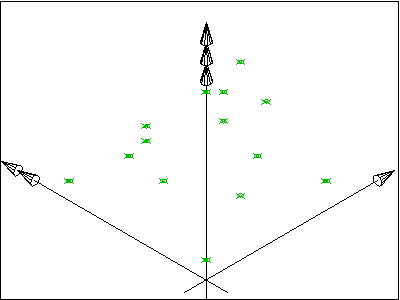 |
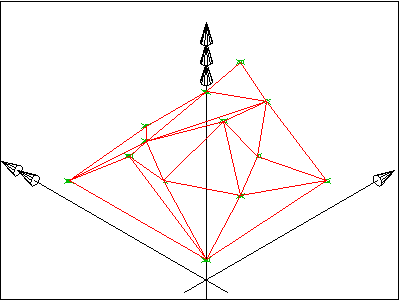 |
Figure 1 — Site survey points |
Figure 2 — Site survey points facetation |
Figure 3 shows A set of survey points, given as 3D Cartesian points, and a set of break points, given as a set of lines, connecting some survey points, within the object coordinate system of the site. Figure 4 shows the result after facetation.
The set of IfcCartesianPoint and the set of IfcPolyline are included in the set of IfcGeometricCurveSet.Elements.
 |
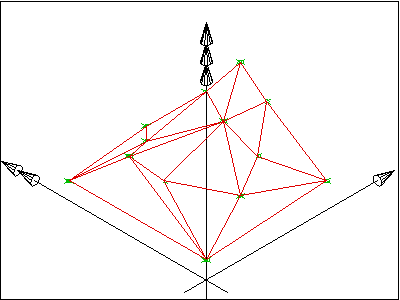 |
Figure 3 — Site breaklines |
Figure 4 — Site breaklines facetation |
NOTE The geometric representation of the site has been based on the ARM level description of the site_shape_representation given within the ISO 10303-225 "Building Elements using explicit shape representation".
|
| Body Geometry | \IfcElement.Representation
\IfcProductDefinitionShape.Representations['Body']
\IfcShapeRepresentation.ContextOfItems
\IfcGeometricRepresentationContext
| The body representation of IfcSite is defined using a solid or surface model. Applicable solids are the IfcFacetedBrep or on the IfcFacetedBrepWithVoids, applicable surface models are the IfcFaceBasedSurfaceModel and the IfcShellBasedSurfaceModel.
The representation identifier and type of this representation of IfcSite is:
- IfcShapeRepresentation.RepresentationIdentifier = 'Body'
- IfcShapeRepresentation.RepresentationType = 'Brep', or 'SurfaceModel'
|
| Field | Mapping | Definition |
|---|
| (Query) | \IfcSlab
| |
|---|
| Object Typing | \IfcObject.IsTypedBy[*]
\IfcRelDefinesByType.RelatingType
\IfcTypeObject.Name
| Optional name for use by the participating software systems or users. For some subtypes of IfcRoot the insertion of the Name attribute may be required. This would be enforced by a where rule. |
| \IfcObject
| The IFC class identifier indicating the subtype of object. |
| \IfcObject.IsDefinedBy[*]
\IfcRelDefinesByProperties.RelatingPropertyDefinition
\IfcElementQuantity.Name
\IfcLabel
| Optional name for use by the participating software systems or users. For some subtypes of IfcRoot the insertion of the Name attribute may be required. This would be enforced by a where rule. |
| Material Layer Set | \IfcObjectDefinition.HasAssociations[*]
\IfcRelAssociatesMaterial.RelatingMaterial
\IfcMaterialLayerSet.MaterialLayers[*]
\IfcMaterialLayer.Name
\IfcLabel
| The material of the IfcSlab is defined by IfcMaterialLayerSet, or as fallback by IfcMaterial, and it is attached either directly or at the IfcSlabType.
NOTE It is illegal to assign an IfcMaterialLayerSetUsage to an IfcSlab. Only the subtype IfcSlabStandardCase supports this concept.
|
| Spatial Containment | \IfcElement.ContainedInStructure[*]
\IfcRelContainedInSpatialStructure.RelatingStructure
\IfcSpatialElement.Name
\IfcLabel
| The IfcSlab, as any subtype of IfcBuildingElement, may participate alternatively in one of the two different containment relationships:
- the Spatial Containment (defined here), or
- the Element Composition.
|
| Surface Geometry | \IfcElement.Representation
\IfcProductDefinitionShape.Representations[*]
\IfcShapeRepresentation.ContextOfItems
\IfcGeometricRepresentationContext
|
NOTE The 'Surface' can be used to define a surfacic model of the building (e.g. for analytical purposes, or for reduced Level of Detail representation).
|
| Body SweptSolid Geometry | \IfcElement.Representation
\IfcProductDefinitionShape.Representations[*]
\IfcShapeRepresentation.ContextOfItems
\IfcGeometricRepresentationContext
| The following additional constraints apply to the swept solid representation:
- Solid: IfcExtrudedAreaSolid is required,
- Profile: IfcArbitraryClosedProfileDef, IfcRectangleProfileDef, IfcCircleProfileDef, IfcEllipseProfileDef shall be supported.
- Extrusion: The profile can be extruded perpendicularly or non-perpendicularly to the plane of the swept profile.
Figure 1 illustrates a 'SweptSolid' geometric representation.
NOTE The following interpretation of dimension parameter applies for polygonal slabs (in ground floor view): > * IfcArbitraryClosedProfileDef.OuterCurve: closed bounded curve interpreted as area (or foot print) of the slab.
 | Figure 1 — Slab body extrusion |
|
| Body Clipping Geometry | \IfcElement.Representation
\IfcProductDefinitionShape.Representations[*]
\IfcShapeRepresentation.ContextOfItems
\IfcGeometricRepresentationContext
| The following constraints apply to the 'Clipping' representation:
- Solid: see 'SweptSolid' shape representation,
- Profile: see 'SweptSolid' shape representation,
- Extrusion: see 'SweptSolid' shape representation,
- Boolean result: The IfcBooleanClippingResult shall be supported, allowing for Boolean differences between the swept solid (here IfcExtrudedAreaSolid) and one or several IfcHalfSpaceSolid.
Figure 1 illustrates a 'Clipping' geometric representation with definition of a roof slab using advanced geometric representation. The profile is extruded non-perpendicular and the slab body is clipped at the eave.
 | Figure 1 — Slab body clipping |
|
| Voiding | \IfcElement.HasOpenings[*]
\IfcRelVoidsElement.RelatedOpeningElement
\IfcOpeningElement.PredefinedType
\IfcOpeningElementTypeEnum
| Predefined generic type for an opening that is specified in an enumeration. There may be a property set given specificly for the predefined types.
{ .change-ifc2x4}
> IFC4 CHANGE The attribute has been added at the end of the entity definition. |
| Product Assignment | \IfcProduct.ReferencedBy[*]
\IfcRelAssignsToProduct.RelatedObjects[*]
\IfcObject
| Related objects, which are assigned to a single object. The type of the single (or relating) object is defined in the subtypes of IfcRelAssigns. |
| Field | Mapping | Definition |
|---|
| (Query) | \IfcSlabStandardCase
| |
|---|
| Material Layer Set Usage | \IfcProduct.HasAssociations[*]
\IfcRelAssociatesMaterial.RelatingMaterial
\IfcMaterialLayerSetUsage.ForLayerSet
\IfcMaterialLayerSet.MaterialLayers[*]
\IfcMaterialLayer.Name
| Multi-layer slabs can be represented by refering to several IfcMaterialLayer's within the IfcMaterialLayerSet that is referenced from the IfcMaterialLayerSetUsage.
Material information can also be given at the IfcSlabType, defining the common attribute data for all occurrences of the same type. It is then accessible by the inverse IsDefinedBy relationship pointing to IfcSlabType.HasAssociations and via IfcRelAssociatesMaterial.RelatingMaterial. The IfcSlabStandardCase defines in addition that the IfcSlabType should have a unique IfcMaterialLayerSet, that is referenced by the IfcMaterialLayerSetUsage assigned to all occurrences of this IfcSlabType.
Figure 2 illustrates slab material usage, where the following conventions shall be met:
- The reference coordinate system is the coordinate system established by the IfcExtrudedAreaSolid.Position.
- The reference plane is the plane defined by the extruded profile of IfcExtrudedAreaSolid.SweptSolid. The IfcMaterialLayerSetUsage.OffsetFromReferenceLine is given as a distance from this plane.
- The IfcMaterialLayerSetUsage.DirectionSense defines how the IfcMaterialLayer's are assigned to the reference plane. POSITIVE means in direction to the positive z-axis of the reference coordinate system.
- The IfcMaterialLayerSetUsage.OffsetFromReferenceLine is the distance parallel to the reference plane and always perpendicular to the base (XY) plane of the reference coordinate system. This is independent of a potential non-perpendicular extrusion given by IfcExtrudedAreaSolid.ExtrudedDirection <> 0.,0.,1. A positive value of IfcMaterialLayerSetUsage.OffsetFromReferenceLine would then point into the positive z-axis of the reference coordinate system.
- The Thickness of each IfcMaterialLayer shall be the parallel distance (measured perpendicular to the base plane). The TotalThickness of the IfcMaterialLayerSet is the sum of all layer thicknesses and in case of a perpendicular extrusion identical with IfcExtrudedAreaSolid.Depth
- The IfcMaterialLayerSetUsage.LayerSetDirection is always AXIS3.

|
 |
Figure 2 — Slab material layers |
|
| Product Placement | \IfcProduct.ObjectPlacement
\IfcLocalPlacement.RelativePlacement
\IfcAxis2Placement3D
| The following restriction is imposed:
- The local placement shall provide the location and directions for the standard slab, the x/y plane is the plane for the profile, and the z-axis is the extrusion axis for the slab body.
|
| Body SweptSolid Geometry | \IfcElement.Representation
\IfcProductDefinitionShape.Representations[*]
\IfcShapeRepresentation.ContextOfItems
\IfcGeometricRepresentationContext
| The following additional constraints apply to the swept solid representation:
- Solid: IfcExtrudedAreaSolid is required,
- Profile: IfcArbitraryClosedProfileDef, IfcRectangleProfileDef, IfcCircleProfileDef, IfcEllipseProfileDef shall be supported.
- Extrusion: The profile can be extruded perpendicularly or non-perpendicularly to the plane of the swept profile.
- Material: The definition of the IfcMaterialLayerSetUsage, particularly of the OffsetFromReferenceLine and the ForLayerSet.TotalThickness, has to be consistent to the 'SweptSolid' representation.
 |
EXAMPLE Figure 1 illustrates a 'SweptSolid' geometric representation. The following interpretation of dimension parameter applies for polygonal slabs (in ground floor view):
IfcArbitraryClosedProfileDef.OuterCurve: closed bounded curve interpreted as area (or foot print) of the slab.
|
Figure 1 — Slab body extrusion |
|
|
| Body Clipping Geometry | \IfcElement.Representation
\IfcProductDefinitionShape.Representations[*]
\IfcShapeRepresentation.ContextOfItems
\IfcGeometricRepresentationContext
| The following constraints apply to the 'Clipping' representation:
- Solid: see 'SweptSolid' shape representation,
- Profile: see 'SweptSolid' shape representation,
- Extrusion: see 'SweptSolid' shape representation,
- Material: see 'SweptSolid' shape representation,
- Boolean result: The IfcBooleanClippingResult shall be supported, allowing for Boolean differences between the swept solid (here IfcExtrudedAreaSolid) and one or several IfcHalfSpaceSolid.
 |
EXAMPLE Figure 1 illustrates a 'Clipping' geometric representation with definition of a roof slab using advanced geometric representation. The profile is extruded non-perpendicular and the slab body is clipped at the eave.
|
Figure 1 — Slab body clipping |
|
|
| Field | Mapping | Definition |
|---|
| (Query) | \IfcSpace
| |
|---|
| Spatial Composition | \IfcSpatialElement.Decomposes[*]
\IfcRelAggregates.RelatingObject
\IfcProject.Name
| By using the inverse relationship IfcSpace.IsDecomposedBy it references IfcSpace by IfcRelAggregates.RelatedObjects. If it refers to another instance of IfcSpace, the referenced IfcSpace needs to have a different and lower CompositionType, i.e. ELEMENT (if the other IfcSpace has COMPLEX), or PARTIAL (if the other IfcSpace has ELEMENT).
|
| Spatial Decomposition | \IfcObjectDefinition.IsDecomposedBy[*]
\IfcRelAggregates.RelatedObjects[*]
\IfcSpatialElement.Name
\IfcLabel
| By using the inverse relationship IfcSpace.Decomposes it references IfcSite || IfcBuildingStorey || IfcSpace by IfcRelAggregates.RelatingObject. If it refers to another instance of IfcSpace, the referenced IfcSpace needs to have a different and higher CompositionType, i.e. COMPLEX (if the other IfcSpace has ELEMENT), or ELEMENT (if the other IfcSpace has PARTIAL).
|
| Spatial Container | \IfcSpatialElement.ContainsElements[*]
\IfcRelContainedInSpatialStructure.RelatedElements[*]
\IfcProduct
| If there are building elements and/or other elements directly related to the IfcSpace (like most furniture and distribution elements), they are associated with the IfcSpace by using the objectified relationship IfcRelContainedInSpatialStructure. The IfcSpace references them by its inverse relationship:
- IfcSpace.ContainsElements -- referencing any subtype of IfcProduct (with the exception of other spatial structure element) by IfcRelContainedInSpatialStructure.RelatedElements.
|
| \IfcObject
| The IFC class identifier indicating the subtype of object. |
| \IfcObject.IsDefinedBy[*]
\IfcRelDefinesByProperties.RelatingPropertyDefinition
\IfcElementQuantity.Name
\IfcLabel
| Optional name for use by the participating software systems or users. For some subtypes of IfcRoot the insertion of the Name attribute may be required. This would be enforced by a where rule. |
| Space Boundaries 1st Level | \IfcSpace.BoundedBy[*]
\IfcRelSpaceBoundary1stLevel.RelatedBuildingElement
\IfcElement
| Reference to ~~Building~~ Element, that defines the Space Boundaries.
{ .change-ifc2x}
> IFC2x CHANGE The data type has been changed from _IfcBuildingElement_ to _IfcElement_ with upward compatibility for file based exchange.
{ .change-ifc2x4}
> IFC4 CHANGE The attribute has been changed to be mandatory. |
| Space Boundaries 2nd Level | \IfcSpace.BoundedBy[*]
\IfcRelSpaceBoundary2ndLevel.RelatedBuildingElement
\IfcElement
| Reference to ~~Building~~ Element, that defines the Space Boundaries.
{ .change-ifc2x}
> IFC2x CHANGE The data type has been changed from _IfcBuildingElement_ to _IfcElement_ with upward compatibility for file based exchange.
{ .change-ifc2x4}
> IFC4 CHANGE The attribute has been changed to be mandatory. |
| Product Local Placement | \IfcProduct.ObjectPlacement
\IfcLocalPlacement.RelativePlacement
\IfcAxis2Placement3D
| The local placement for IfcSpace is defined at its supertype IfcProduct. It is defined by the IfcLocalPlacement, which defines the local coordinate system that is referenced by all geometric representations.
|
| FootPrint GeomSet Geometry | \IfcProduct.Representation
\IfcProductDefinitionShape.Representations[*]
\IfcShapeRepresentation.RepresentationIdentifier
\IfcLabel
| The following constraints apply to the 2D representation:
 |
EXAMPLE Figure 1 shows a two-dimensional bounded curve representing the
foot print of IfcSpace. |
Figure 1 — Space footprint |
|
|
| Body SweptSolid Geometry | \IfcElement.Representation
\IfcProductDefinitionShape.Representations[*]
\IfcShapeRepresentation.ContextOfItems
\IfcGeometricRepresentationContext
| The following constraints apply to the standard representation:
Figure 1 shows an extrusion of an arbitrary profile definition with voids into the swept area solid of IfcSpace.
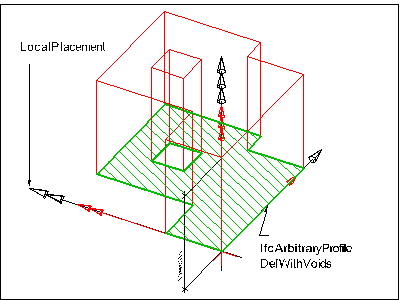 | Figure 1 — Space body swept solid |
|
| Body Clipping Geometry | \IfcElement.Representation
\IfcProductDefinitionShape.Representations[*]
\IfcShapeRepresentation.ContextOfItems
\IfcGeometricRepresentationContext
| The following additional constraints apply to the advanced representation:
Figure 1 shows an extrusion of an arbitrary profile definition into the swept area solid. The solid and an half space solid are operands of the Boolean result of IfcSpace.
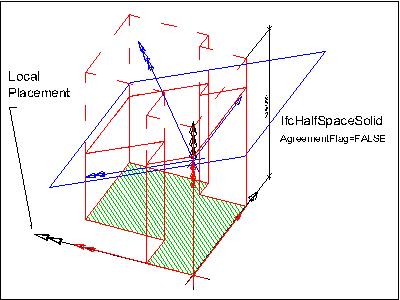 | Figure 1 — Space body clipping |
|
| Body Brep Geometry | \IfcElement.Representation
\IfcProductDefinitionShape.Representations[*]
\IfcShapeRepresentation.ContextOfItems
\IfcGeometricRepresentationContext
| The space can be represented by a brep geometry representation
|
| Field | Mapping | Definition |
|---|
| (Query) | \IfcStair
| |
|---|
| Object Typing | \IfcObject.IsTypedBy[*]
\IfcRelDefinesByType.RelatingType
\IfcTypeObject.Name
| Optional name for use by the participating software systems or users. For some subtypes of IfcRoot the insertion of the Name attribute may be required. This would be enforced by a where rule. |
| \IfcObject
| The IFC class identifier indicating the subtype of object. |
| Material Solid | \IfcObjectDefinition.HasAssociations[*]
\IfcRelAssociatesMaterial.RelatingMaterial
\IfcMaterial
| The material of the IfcStair is defined by the IfcMaterial and attached by the IfcRelAssociatesMaterial.RelatingMaterial. It is accessible by the inverse HasAssociations relationship.
Material information can also be given at the IfcStairType, defining the common attribute data for all occurrences of the same type. It is then accessible by the inverse IsDefinedBy relationship pointing to IfcStair.HasAssociations and via IfcRelAssociatesMaterial.RelatingMaterial to IfcMaterial. If both are given, then the material directly assigned to IfcStair overrides the material assigned to IfcStairType.
|
| Spatial Containment | \IfcElement.ContainedInStructure[*]
\IfcRelContainedInSpatialStructure.RelatingStructure
\IfcSpatialElement.Name
\IfcLabel
| The IfcStair, as any subtype of IfcBuildingElement, may participate alternatively in one of the two different containment relationships:
- the Spatial Containment (defined here), or
- the Element Composition.
|
| Element Decomposition | \IfcElement.IsDecomposedBy[*]
\IfcRelAggregates.RelatedObjects[*]
\IfcElement.Name
\IfcLabel
| Geometric representation by aggregated elements
If the IfcStair has components (referenced by SELF\IfcObject.IsDecomposedBy) with own 'Body' representation, then no 'Body' representation shall defined for the IfcStair. The IfcStair shape is then represented by the geometric representation of its components. The components are accessed via SELF\IfcObject.IsDecomposedBy[1].RelatedObjects.
Figure 1 illustrates stair placement, where the IfcStair defines the local placement for all components and the common 'Axis' representation, and each component has its own 'Body' representation.
 | Figure 1 — Stair placement |
|
| Placement | \IfcProduct.ObjectPlacement
\IfcLocalPlacement.RelativePlacement
\IfcAxis2Placement3D
| The following restriction may be imposed by view definitions or implementer agreements:
- If the IfcStair establishes an aggregate, then all contained elements shall be placed relative to the IfcStair.ObjectPlacement.
|
| Axis 2D Geometry | \IfcElement.Representation
\IfcProductDefinitionShape.Representations['Axis']
\IfcShapeRepresentation.ContextOfItems
\IfcGeometricRepresentationContext
| The walking line is represented by a two-dimensional open curve as the axis. The curve is directed into the upward direction (direction has to be interpreted as specified at the subtypes of IfcCurve).
NOTE The 'Axis' representation of IfcStair may be provided even if the IfcStair has components with own shape representations.
|
| Body SweptSolid Geometry | \IfcElement.Representation
\IfcProductDefinitionShape.Representations[*]
\IfcShapeRepresentation.ContextOfItems
\IfcGeometricRepresentationContext
| Definition of the representation context for which the different subtypes of representation are valid. |
| Field | Mapping | Definition |
|---|
| (Query) | \IfcStructuralCurveMember
| |
|---|
| Structural Connectivity | \IfcStructuralMember.ConnectedBy[*]
\IfcRelConnectsStructuralMember.RelatedStructuralConnection
\IfcStructuralConnection
| Reference to an instance of IfcStructuralConnection (or its subclasses) which is connected to the specified structural member. |
| Material Profile Set Usage | \IfcProduct.HasAssociations[*]
\IfcRelAssociatesMaterial.RelatingMaterial
\IfcMaterialProfileSetUsage.ForProfileSet
\IfcMaterialProfileSet.MaterialProfiles[*]
\IfcMaterialProfile.Name
| The material of direct instances IfcStructuralCurveMember (in contrast to instances of the subtype IfcStructuralCurveMemberVarying) is defined by IfcMaterialProfileSetUsage and attached by the IfcRelAssociatesMaterial.RelatingMaterial. It is accessible by the inverse HasAssociations relationship. Composite profile beams can be represented by refering to several _IfcMaterialProfile_s within the IfcMaterialProfileSet that is referenced from the IfcMaterialProfileSetUsage. In case of tapered members, the material profile usage subtype IfcMaterialProfileSetUsageDual is used which specifies _IfcMaterialProfileSet_s separately at the start and the end of the tapered member.
The material (IfcMaterial) in each IfcMaterialProfile(Set) is specified minimally by a name which corresponds with an agreed upon standardized structural material designation. An external reference to the source which specifies the material designation should be provided. Alternatively, structural material properties may be provided by means of IfcMechanicalMaterialProperties and IfcExtendedMaterialProperties.
The profile (IfcProfileDef) in each IfcMaterialProfile(Set) is specified minimally by a name which corresponds with an agreed upon standardized structural profile designation. An external reference to the source which specifies the profile designation should be provided. Alternatively or additionally, explicit profile geometry should be provided by using respective subtypes of IfcProfileDef. Alternatively or additionally, structural profile properties may be provided by means of subtypes of IfcProfileProperties.
An IfcProfileDef is a two-dimensional geometric object with a xp,yp coordinate system. The profile is inserted into the curve member model thus that the origin of xp,yp is located at the member's reference curve and that xp,yp are parallel with and directed like the local y,z.
NOTE Due to convention in structural mechanics, axis names of IfcStructuralCurveMember differ from axis names of building elements like IfcBeamStandardCase: The extrusion axis of IfcStructuralCurveMember is called x while the extrusion axis of IfcBeamStandardCase is called z. Hence x,y,z of IfcStructuralCurveMember correspond with z,x,y of IfcBeamStandardCase.
If the profile is meant to be inserted centrically in terms of structural section properties, it is necessary that the origin of xp,yp is identical with the geometric centroid of the profile (commonly also called centre of gravity). If subtypes of IfcParameterizedProfileDef are used which are only singly symmetric or are asymmetric, an explicit translation by IfcParameterizedProfileDef.Position.Location is required then.
If the profile is inserted at its geometric centroid, IfcMaterialProfileSetUsage.CardinalPoint shall be set to 10.
Otherwise, the profile is inserted eccentrically and a different cardinal point should be set accordingly.
NOTE Another eccentricity model is available independently of eccentric profile specification: The reference curve of the member may be located eccentrically relative to the reference points of the connected _IfcStructuralPointConnection_s. The connection relationship is then established by IfcRelConnectsWithEccentricity. Whether one or the other or both eccentricity models may be used is subject to information requirements and local agreements.
|
| Reference Topology | \IfcProduct.Representation
\IfcProductDefinitionShape.Representations[*]
\IfcTopologyRepresentation.ContextOfItems
\IfcGeometricRepresentationContext
| Direct instances of IfcStructuralCurveMember shall have a topology representation which consists of one instance of IfcEdge or a subtype, representing the reference curve of the curve member. See definitions at IfcStructuralItem for further specifications.
Informal Propositions:
- The reference curve must not be parallel with Axis at any point within the curve member's domain.
The local coordinate system is established by the reference curve given by topology representation and by the attribute Axis. The local x axis is parallel with the tangent on the reference curve. The local z axis is located in the surface which is created by sweeping Axis along the reference curve and is directed according to Axis. The local y axis is directed such that x,y,z form a right-handed Cartesian coordinate system.
|
| Field | Mapping | Definition |
|---|
| (Query) | \IfcTask
| |
|---|
| Object Typing | \IfcObject.IsTypedBy[*]
\IfcRelDefinesByType.RelatingType
\IfcTypeObject.Name
| The IfcTask defines the anticipated or actual occurrence of any task; common information about task types is handled by IfcTaskType.
EXAMPLE It includes fixed duration, fixed unit or fixed work. An IfcTask can be aggregated to a task type in order to specify a task sequence or any time related information, e.g. the duration of a task. Please see the documentation of IfcTaskType for further information.
|
| Property Sets | \IfcObject
| The IFC class identifier indicating the subtype of object. |
| Nesting | \IfcObjectDefinition.IsNestedBy[*]
\IfcRelNests.RelatedObjects[*]
\IfcObject
| IfcTask may be contained within an IfcTask using the IfcRelNests relationship. An IfcTask may in turn nest other IfcTask, IfcProcedure or IfcEvent entities. Such nesting indicates decomposed level of detail. From IFC4 onwards it is required to have a summary task (root of all tasks), which is used to define a link to the work plan or work schedule. All subtasks of the summary tasks are then implicitly linked to this work plan or work schedule. Please note that the summary task is used for data organization and not meant to store typical task information as defined by the user. It is therefore recommended that the summary task is hidden from the user to avoid confusion. Please also note that IfcRelNests is used to show the dependency between regular tasks and recurring task definitions (please see the section about time and duration use definitions).
As shown in Figure 1, the installation of a number of items of equipment within a particular space may be the subject of a single task which is identified as 'fix equipment in space 123'. IfcTask represents the occurrence of a work performance of a type of process in a construction plan.
 | Figure 1 — Task visualization |
A task may nest other tasks as sub-items; the nesting relationship is modeled by IfcRelNests as shown in Figure 2. For example, the construction of a stud wall may be designated as a nesting task named 'install wall #1' including other tasks such as 'install dry wall', 'install studs', 'wall taping', and 'erect wall' as sub-processes. A value that indicates the relative tree view position of the task (in comparison to the tree view position of other tasks and the task hierarchy defined by IfcRelNests).
The task order information that is used for viewing purposes is derived from the order defined by the IfcRelNests relationship and thus is independent of the logical task order defined through IfcRelSequence. The hierarchy and order defined through IfcRelNests enables to order the tasks in a tree view or list view structure.
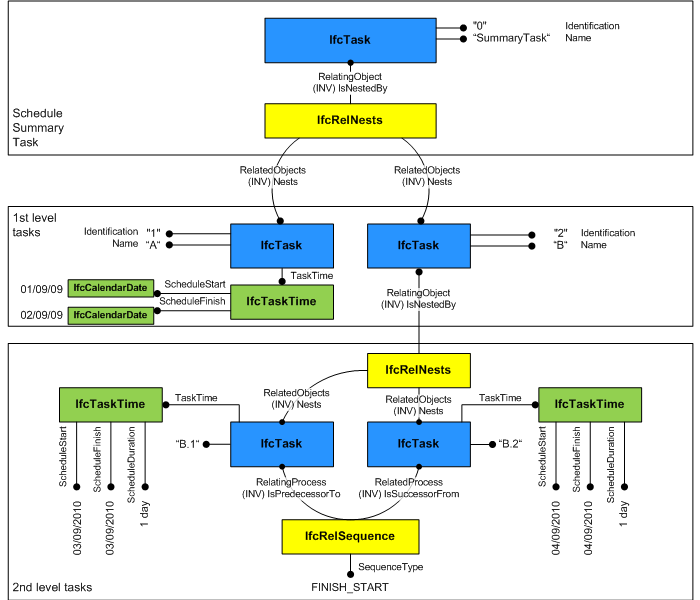 | Figure 2 — Task nesting relationships |
A top-level task is declared within the IfcProject using the IfcRelDeclares relationship.
|
| Sequential Connectivity | \IfcProcess.IsPredecessorTo[*]
\IfcRelSequence.RelatedProcess
\IfcProcess
| The relationship IfcRelSequence is used to indicate control flow. An IfcTask as a successor to an IfcTask indicates logical sequence how these tasks should be performed. IfcTask's can be triggered or can trigger IfcEvent's, which is also defined through the relationship IfcRelSequence.
|
| Control Assignment | \IfcControl.Controls[*]
\IfcRelAssignsToControl.RelatedObjects[*]
\IfcObject
| Occurrences of IfcTask may be assigned to an IfcWorkControl (either a work plan or a work schedule) through IfcRelAssignsToControl. Please note that the IfcRelAssignsTasks relationship class has been removed in IFC4 and is no longer available.
|
| Process Assignment | \IfcProcess.OperatesOn[*]
\IfcRelAssignsToProcess.RelatedObjects[*]
\IfcResource
| It is suggested to use the 'summary task' (root element of the task hierarchy that is required for task management purposes) to assign all subtask to a work plan or work schedule. Resources used by tasks are assigned by IfcRelAssignsToProcess.
|
| Product Assignment | \IfcProduct.ReferencedBy[*]
\IfcRelAssignsToProduct.RelatedObjects[*]
\IfcObject
| Related objects, which are assigned to a single object. The type of the single (or relating) object is defined in the subtypes of IfcRelAssigns. |
| Classification | \IfcObjectDefinition.HasAssociations[*]
\IfcRelAssociatesClassification.RelatingClassification
\IfcClassificationReference.Identification
\IfcIdentifier
| An IfcTask may be assigned a Work Breakdown Structure (WBS) code. A WBS code is dealt with as a classification of task and is associated to a task occurrence using the IfcRelAssociatesClassification relationship class. As well as being to designate the code, the classification structure also enables the source of the work breakdown structure classification to be identified.
|
| Constraint | \IfcObjectDefinition.HasAssociations[*]
\IfcRelAssociatesConstraint.RelatingConstraint
\IfcObjective.BenchmarkValues[*]
\IfcMetric.DataValue
\IfcMetricValueSelect
| Constraints may be applied to a task to indicate fixed task duration, fixed start or fixed finish, where IfcMetric.ReferencePath is set to the corresponding attribute on the IfcTaskTime entity.
|
| Field | Mapping | Definition |
|---|
| (Query) | \IfcWall
| |
|---|
| Object Typing | \IfcObject.IsTypedBy[*]
\IfcRelDefinesByType.RelatingType
\IfcTypeObject.Name
| Optional name for use by the participating software systems or users. For some subtypes of IfcRoot the insertion of the Name attribute may be required. This would be enforced by a where rule. |
| \IfcObject
| The IFC class identifier indicating the subtype of object. |
| \IfcObject.IsDefinedBy[*]
\IfcRelDefinesByProperties.RelatingPropertyDefinition
\IfcElementQuantity.Name
\IfcLabel
| Optional name for use by the participating software systems or users. For some subtypes of IfcRoot the insertion of the Name attribute may be required. This would be enforced by a where rule. |
| Material Layer Set | \IfcObjectDefinition.HasAssociations[*]
\IfcRelAssociatesMaterial.RelatingMaterial
\IfcMaterialLayerSet.MaterialLayers[*]
\IfcMaterialLayer.Name
\IfcLabel
| The material of the IfcWall is defined by IfcMaterialLayerSet, or as fallback by IfcMaterial, and it is attached either directly or at the IfcWallType.
NOTE It is illegal to assign an IfcMaterialLayerSetUsage to an IfcWall. Only the subtype IfcWallStandardCase supports this concept.
|
| Path Connectivity | \IfcElement.ConnectedFrom[*]
\IfcRelConnectsPathElements.RelatedElement
\IfcElement
| Reference to a subtype of _IfcElement_ that is connected by the connection relationship in the role of _RelatedElement_. |
| Spatial Containment | \IfcElement.ContainedInStructure[*]
\IfcRelContainedInSpatialStructure.RelatingStructure
\IfcSpatialElement.Name
\IfcLabel
| The IfcWall, as any subtype of IfcBuildingElement, may participate alternatively in one of the two different containment relationships:
- the Spatial Containment (defined here), or
- the Element Composition.
|
| Axis 2D Geometry | \IfcElement.Representation
\IfcProductDefinitionShape.Representations['Axis']
\IfcShapeRepresentation.ContextOfItems
\IfcGeometricRepresentationContext
|
NOTE The 'Axis' is not used to locate the material layer set, only the subtype IfcWallStandardCase provides this capability.
|
| Surface Geometry | \IfcElement.Representation
\IfcProductDefinitionShape.Representations[*]
\IfcShapeRepresentation.ContextOfItems
\IfcGeometricRepresentationContext
|
NOTE The 'Surface' can be used to define a surfacic model of the building (e.g. for analytical purposes, or for reduced Level of Detail representation).
|
| Body SweptSolid Geometry | \IfcElement.Representation
\IfcProductDefinitionShape.Representations[*]
\IfcShapeRepresentation.ContextOfItems
\IfcGeometricRepresentationContext
| The following additional constraints apply to the 'SweptSolid' representation:
NOTE If the wall body can be described by a vertical extrusion of a polygonal footprint with constant thickness along the axis (where vertical = into the direction of the global Z axis), the subtype IfcWallStandardCase should be used. If the extrusion is not equal to global Z, then the IfcWall should be used.
|
| Body Clipping Geometry | \IfcElement.Representation
\IfcProductDefinitionShape.Representations[*]
\IfcShapeRepresentation.ContextOfItems
\IfcGeometricRepresentationContext
| Definition of the representation context for which the different subtypes of representation are valid. |
| Voiding | \IfcElement.HasOpenings[*]
\IfcRelVoidsElement.RelatedOpeningElement
\IfcOpeningElement.PredefinedType
\IfcOpeningElementTypeEnum
| Predefined generic type for an opening that is specified in an enumeration. There may be a property set given specificly for the predefined types.
{ .change-ifc2x4}
> IFC4 CHANGE The attribute has been added at the end of the entity definition. |
| Product Assignment | \IfcProduct.ReferencedBy[*]
\IfcRelAssignsToProduct.RelatedObjects[*]
\IfcObject
| Related objects, which are assigned to a single object. The type of the single (or relating) object is defined in the subtypes of IfcRelAssigns. |
| Field | Mapping | Definition |
|---|
| (Query) | \IfcWallElementedCase
| |
|---|
| Product Local Placement | \IfcProduct.ObjectPlacement
\IfcLocalPlacement.RelativePlacement
\IfcAxis2Placement3D
| The use of local placement is defined at the supertype IfcWall. The local placement of the IfcWallElementedCase defines the parent coordinate systems for the parts within the decomposition. All parts shall be positioned relative to the IfcWallElementedCase.
|
| Surface Geometry | \IfcElement.Representation
\IfcProductDefinitionShape.Representations[*]
\IfcShapeRepresentation.ContextOfItems
\IfcGeometricRepresentationContext
| The 'Surface Geometry' shape representation can be used to define a surfacic model of the building (e.g. for analytical purposes, or for reduced Level of Detail representation). It could suppress the geometric details of the parts in the decomposition.
NOTE It is invalid to exchange a 'Body' shape representation of an IfcWallElementedCase. The body geometry is defined by the parts within the decomposition.
|
| Element Decomposition | \IfcElement.IsDecomposedBy[*]
\IfcRelAggregates.RelatedObjects[*]
\IfcElement.Name
\IfcLabel
| An elemented wall is decomposed into parts for particular components such as framing and panels on each side. There must be an object corresponding to each type of part, however there may be single object instance indicating multiple placements (via mapping geometry) for each part, or multiple instances corresponding to each placement. For minimizing file size, it is recommended to use a single object with multiple placement unless there are specific connectivity relationships indicated (e.g. a junction box connected to a specific stud).
|
| Element Voiding | \IfcElement.HasOpenings[*]
\IfcRelVoidsElement.RelatedOpeningElement
\IfcOpeningElement.PredefinedType
\IfcOpeningElementTypeEnum
| As shown in Figure 1, openings within the composite wall are directly assigned to IfcWallElementedCase using IfcRelVoidsElement pointing to IfcOpeningElement and apply to all aggregated parts. If individual parts have cutting and other voiding features, then the decomposed parts have a separate voiding relationship IfcRelVoidsElement pointing to IfcVoidingFeature.
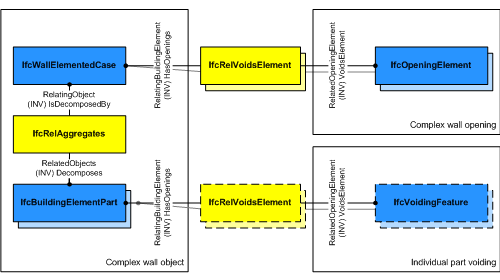 | Figure 1 — Wall elemented voiding |
|
| Field | Mapping | Definition |
|---|
| (Query) | \IfcWallStandardCase
| |
|---|
| Material Layer Set Usage | \IfcProduct.HasAssociations[*]
\IfcRelAssociatesMaterial.RelatingMaterial
\IfcMaterialLayerSetUsage.ForLayerSet
\IfcMaterialLayerSet.MaterialLayers[*]
\IfcMaterialLayer.Name
| Multi-layer walls can be represented by refering to several IfcMaterialLayer's within the IfcMaterialLayerSet that is referenced from the IfcMaterialLayerSetUsage.
Material information can also be given at the IfcWallType, defining the common attribute data for all occurrences of the same type. It is then accessible by the inverse IsDefinedBy relationship pointing to IfcSlabType.HasAssociations and via IfcRelAssociatesMaterial.RelatingMaterial.
The IfcWallType should then have a unique IfcMaterialLayerSet, that is referenced by the IfcMaterialLayerSetUsage assigned to all occurrences of this IfcWallType.
Figure 2 illustrates material layer usage, where the following conventions shall be met:
- The reference coordinate system is the local coordinate system established by the ObjectPlacement of the IfcWallStandardCase.
- The reference axis is the axis defined by the IfcShapeRepresentation with RepresentationType='Axis' as one of the Representation.Representations of the IfcWallStandardCase.
- The IfcMaterialLayerSetUsage.OffsetFromReferenceLine is given as a distance from this axis.
- The IfcMaterialLayerSetUsage.OffsetFromReferenceLine is the distance parallel to the reference axis and always within the base (XY) plane of the reference coordinate system. A positve value of IfcMaterialLayerSetUsage.OffsetFromReferenceLine would then point into the positive y-axis of the reference coordinate system.
- The IfcMaterialLayerSetUsage.DirectionSense defines how the IfcMaterialLayer's are assigned to the reference axis. POSITIVE means in direction to the positive y-axis of the reference coordinate system.
- The Thickness of each IfcMaterialLayer is provided starting from the OffsetFromReferenceLine and in the direction given by DirectionSense. It is applied without any gap or overlap between two consecutive layers. The TotalThickness of the IfcMaterialLayerSet is the sum of all layer thicknesses.
- The IfcMaterialLayerSetUsage.LayerSetDirection is always AXIS2.
 | Figure 2 — Wall material layers |
|
| Product Placement | \IfcProduct.ObjectPlacement
\IfcLocalPlacement.RelativePlacement
\IfcAxis2Placement3D
| The following restriction is imposed:
- The local placement shall provide the location and directions for the standard wall, the x/y plane is the plane for the profile, and the z-axis is the extrusion axis for the wall body.
|
| Axis 2D Geometry | \IfcElement.Representation
\IfcProductDefinitionShape.Representations['Axis']
\IfcShapeRepresentation.ContextOfItems
\IfcGeometricRepresentationContext
| The wall axis is represented by a two-dimensional open curve within a particular shape representation. The wall axis is used to apply the material layer set usage parameter to the wall geometry.
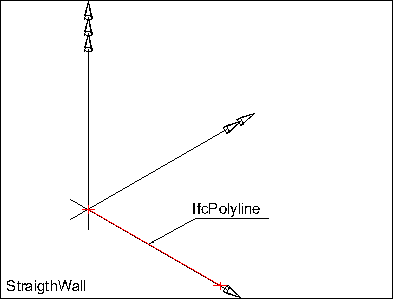 |
EXAMPLE Figure 1 illustrates an axis representation for a straight wall. In case of a straight wall, the set of items shall
include a single geometric representation item of type IfcPolyline or IfcTrimmedCurve with the BasisCurve being an IfcLine. The IfcPolyline or IfcTrimmedCurve shall be parallel (here in a special case co-linear) to the x-axis
of the object coordinate system. The direction shall be identical to the direction of the x-axis.
|
Figure 1 — Wall axis straight |
|
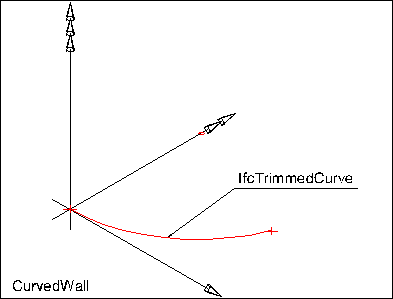 |
EXAMPLE Figure 2 illustrates an axis representation for a curved wall. In case of a curved wall, the set of items shall include
a single geometric representation item of type IfcTrimmedCurve. The curve shall have a BasisCurve of type IfcCircle. The tangent of the IfcTrimmedCurve shall be parallel at start to the x-axis of the object coordinate system. The direction shall be identical to the direction of the x-axis.
|
Figure 2 — Wall axis curved |
|
|
| Body SweptSolid Geometry | \IfcElement.Representation
\IfcProductDefinitionShape.Representations[*]
\IfcShapeRepresentation.ContextOfItems
\IfcGeometricRepresentationContext
| The following additional constraints apply to the 'SweptSolid' representation:
- Solid: IfcExtrudedAreaSolid is required,
- Profile: IfcArbitraryClosedProfileDef and IfcRectangleProfileDef shall be supported.
- Extrusion: The profile shall be extruded vertically, i.e., in the direction of the z-axis of the co-ordinate system of the referred spatial structure element. It might be further constraint to be in the direction of the global z-axis in implementers agreements. The extrusion axis shall be perpendicular to the swept profile, i.e. pointing into the direction of the z-axis of the Position of the IfcExtrudedAreaSolid.
The profile of a wall is described in the ground view and extruded vertically. The profile (also identical with the foot print of the wall) is defined by the IfcArbitraryClosedProfileDef (excluding its subtypes). The profile is given with all wall connections already resolved.
Figure 1 illustrates a body representation for a straight wall. In case of a straight wall, the two sides of the profile shall be parallel to the wall axis, that is, the wall has a single unchanged thickness.
Figure 2 illustrates a body representation for a curved wall. In case of a curved wall, the two sides of the profile shall be parallel (with defined offset) to the wall axis, that is, the wall has a single unchanged thickness.
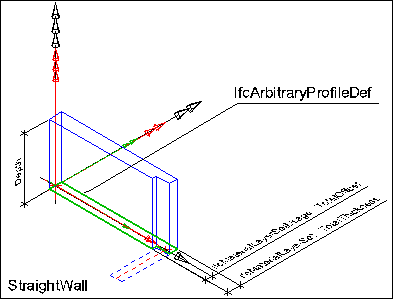 |
 |
Figure 1 — Wall body extrusion straight |
Figure 2 — Wall body extrusion curved |
|
| Body Clipping Geometry | \IfcElement.Representation
\IfcProductDefinitionShape.Representations[*]
\IfcShapeRepresentation.ContextOfItems
\IfcGeometricRepresentationContext
| The following constraints apply to the 'Clipping' representation:
- Solid: see standard geometric representation
- Profile: see standard geometric representation
- Extrusion: see standard geometric representation
- Boolean result: The IfcBooleanClippingResult shall be supported, allowing for Boolean differences between the swept solid (here IfcExtrudedAreaSolid) and one or several IfcHalfSpaceSolid (or subtypes).
Figure 1 illustrates a clipping for a straight wall using an IfcPolygonalBoundedHalfSpace as SecondOperand in the IfcBooleanClippingResult.
Figure 2 illustrates a clipping for a curved wall using an IfcHalfSpaceSolid as SecondOperand in the IfcBooleanClippingResult.
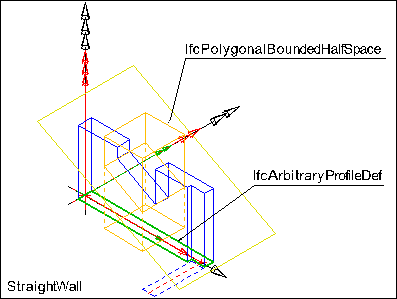 |
 |
Figure 1 — Wall body clipping straight |
Figure 2 — Wall body clipping curved |
|
| Field | Mapping | Definition |
|---|
| (Query) | \IfcWindow
| |
|---|
| Door Attributes | \IfcDoor.Tag
\IfcIdentifier
| The tag (or label) identifier at the particular instance of a product, e.g. the serial number, or the position number. It is the identifier at the occurrence level. |
| \IfcObject
| The IFC class identifier indicating the subtype of object. |
| Object Typing | \IfcObject.IsTypedBy[*]
\IfcRelDefinesByType.RelatingType
\IfcTypeObject.Name
| Optional name for use by the participating software systems or users. For some subtypes of IfcRoot the insertion of the Name attribute may be required. This would be enforced by a where rule. |
| \IfcObject.IsDefinedBy[*]
\IfcRelDefinesByProperties.RelatingPropertyDefinition
\IfcElementQuantity.Name
\IfcLabel
| Optional name for use by the participating software systems or users. For some subtypes of IfcRoot the insertion of the Name attribute may be required. This would be enforced by a where rule. |
| Material Constituent Set | \IfcObjectDefinition.HasAssociations[*]
\IfcRelAssociatesMaterial.RelatingMaterial
\IfcMaterialConstituentSet.MaterialConstituents[*]
\IfcMaterialConstituent.Name
\IfcLabel
| The material of the IfcWindow is defined by the IfcMaterialConstituentSet or as fall back by IfcMaterial and attached by the IfcRelAssociatesMaterial.RelatingMaterial. It is accessible by the inverse HasAssociations relationship.
If the fall back single IfcMaterial is referenced, it applies to the lining and framing of the window.
|
| Spatial Containment | \IfcElement.ContainedInStructure[*]
\IfcRelContainedInSpatialStructure.RelatingStructure
\IfcSpatialElement.Name
\IfcLabel
| The IfcWindow, as any subtype of IfcBuildingElement, may participate alternatively in one of the two different containment relationships:
- the Spatial Containment (defined here), or
- the Element Composition.
The IfcWindow may also be connected to the IfcOpeningElement in which it is placed as a filler. In this case, the spatial containment relationship shall be provided, see Figure 1.
|
| Product Local Placement | \IfcProduct.ObjectPlacement
\IfcLocalPlacement.RelativePlacement
\IfcAxis2Placement3D
| The following restriction is imposed:
- The PlacementRelTo relationship of IfcLocalPlacement shall point to the local placement of the same element (if given), in which the IfcWindow is used as a filling (normally an IfcOpeningElement), as provided by the IfcRelFillsElement relationship.
- If the IfcWindow is not inserted into an IfcOpeningElement, then the PlacementRelTo relationship of IfcLocalPlacement shall point (if given) to the local placement of the same IfcSpatialStructureElement that is used in the ContainedInStructure inverse attribute or to a referenced spatial structure element at a higher level.
- If the relative placement is not used, the absolute placement is defined within the world coordinate system.
NOTE The product placement is used to determine the opening direction of the window.
|
| Profile 3D Geometry | \IfcElement.Representation
\IfcProductDefinitionShape.Representations[*]
\IfcShapeRepresentation.ContextOfItems
\IfcGeometricRepresentationContext
| The window profile is represented by a three-dimensional closed curve within a particular shape representation. The profile is used to apply the parameter of the parametric window representation. The following attribute values for the IfcShapeRepresentation holding this geometric representation shall be used:
- RepresentationIdentifier : 'Profile'
- RepresentationType : 'Curve3D', only a single closed curve shall be contained in the set of IfcShapeRepresentation.Items.
A 'Profile' representation has to be provided if:
- a parametric representation shall be applied to the window AND
-
- the window is 'free standing', or
- the opening into which the window is inserted is not extruded horizontally (i.e. where the opening profile does not match the window profile)
|
| Field | Mapping | Definition |
|---|
| (Query) | \IfcZone
| |
|---|
| \IfcObject
| The IFC class identifier indicating the subtype of object. |
| Group Assignment | \IfcGroup.IsGroupedBy[*]
\IfcRelAssignsToGroup.RelatedObjects[*]
\IfcProduct
| An IfcZone is a spatial system under which individual IfcSpace's (and other IfcZone's) are grouped. In contrary to the IfcSpatialZone entity, IfcZone is a mere grouping, it can not define an own geometric representation and placement. Therefore it cannot be used for spatial zones having a different shape and size compared to the shape and size of aggregated spaces.
NOTE The IfcZone is regarded as the spatial system (as compared to the building service, electrical, or analytical system), the name remains IfcZone for compatibility reasons, instead of using a proper naming convention, like IfcSpatialSystem.
NOTE One of the purposes of a zone is to define a fire compartmentation. In this case it defines the geometric information about the fire compartment (through the contained spaces) and information, whether this compartment is ventilated or sprinkler protected. In addition the fire risk code and the hazard type can be added, the coding is normally defined within a national fire regulation. All that information is available within the relevant property sets. Again, if an independent shape has to be provided to the fire compartment, then the entity IfcSpatialZone shall be used.
In case of a zone denoting a (fire) compartment, the following types should be used, if applicable, as values of the ObjectType attribute:
- 'FireCompartment': a zone of spaces, collected to represent a single fire compartment.
- 'ElevatorShaft': a collection of spaces within an elevator, potentially going through many storeys.
- 'RisingDuct': A collection of vertical airspaces.
- 'RunningDuct': A collection of horizontal airspaces.
|


